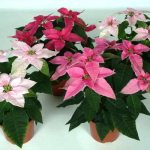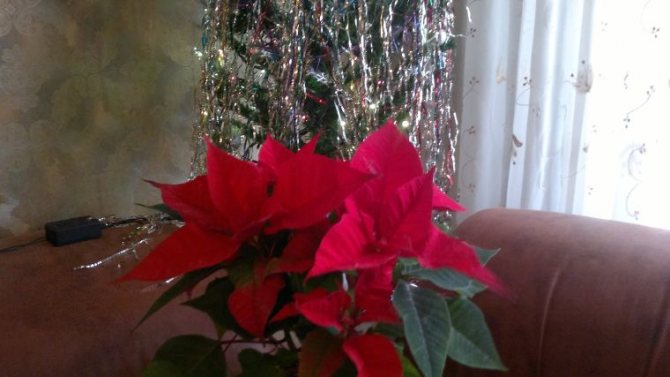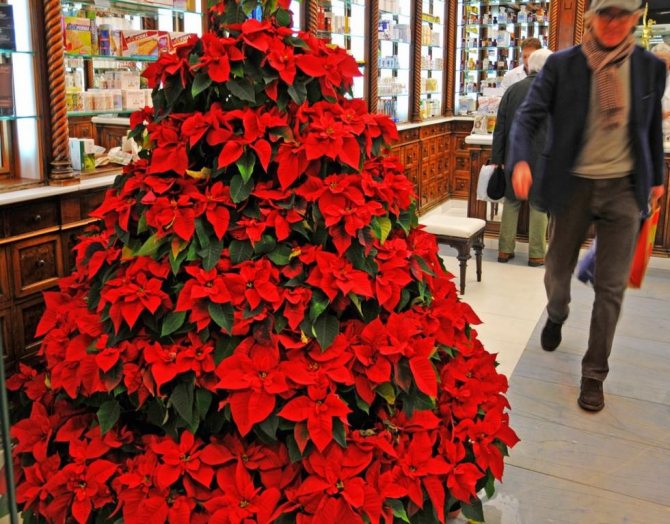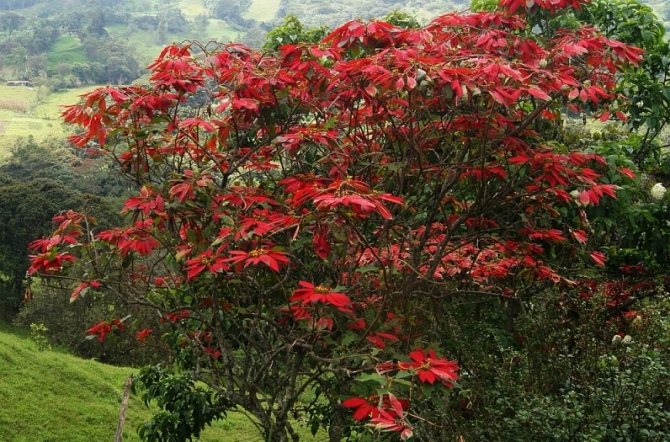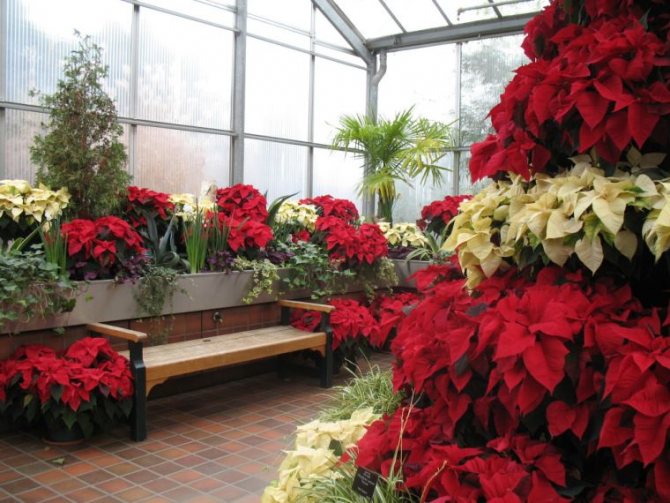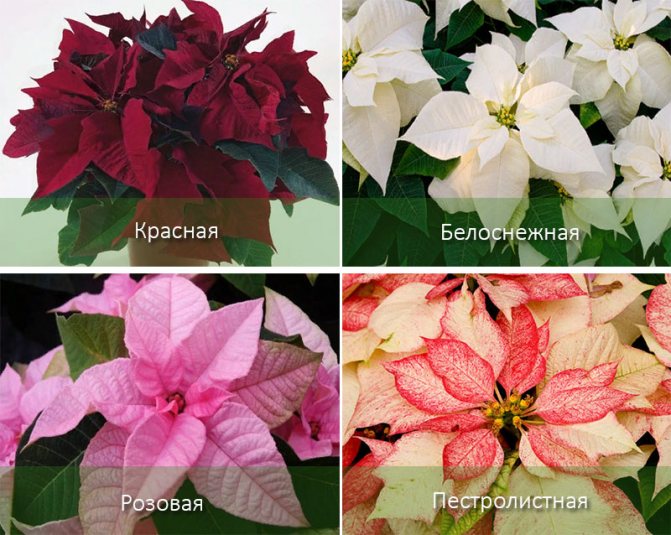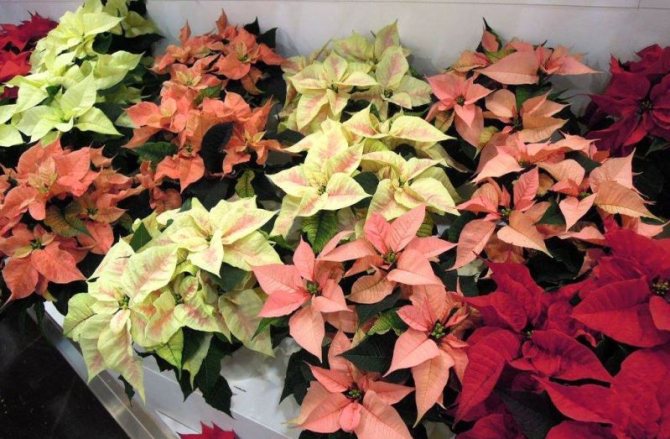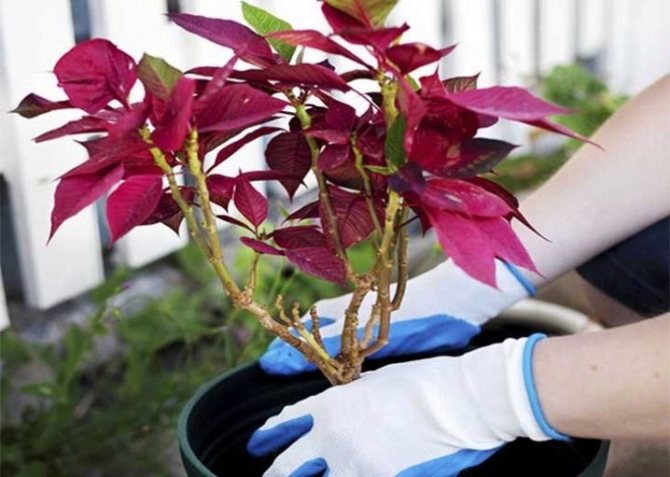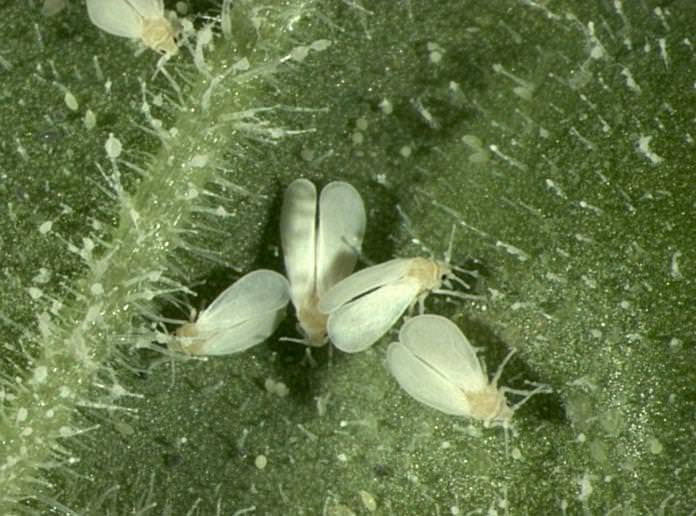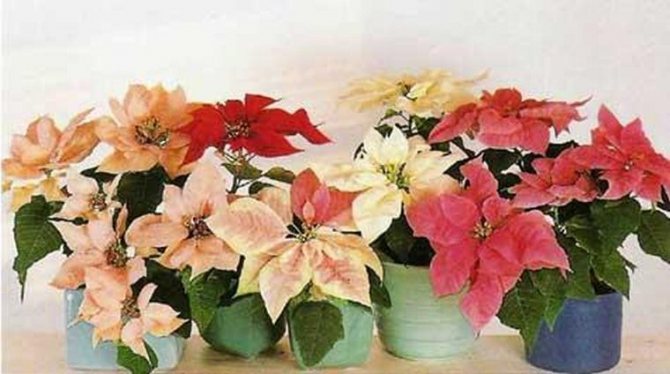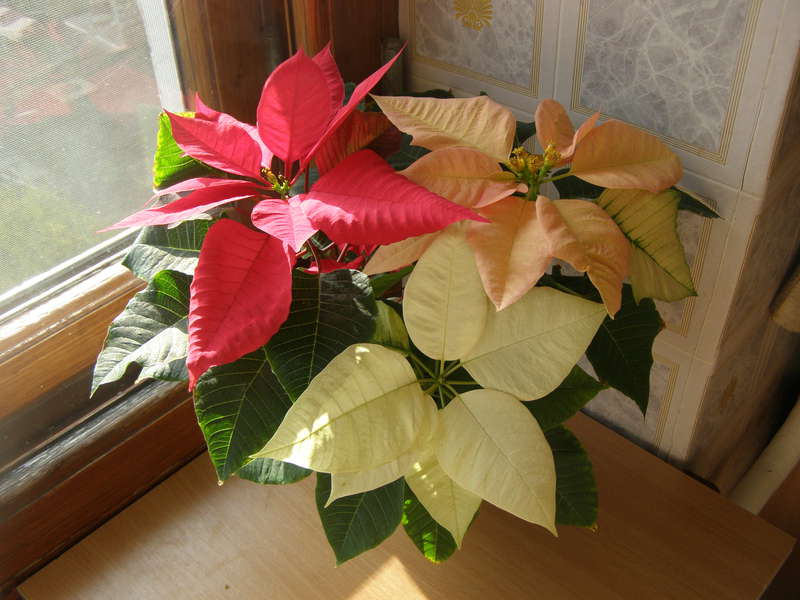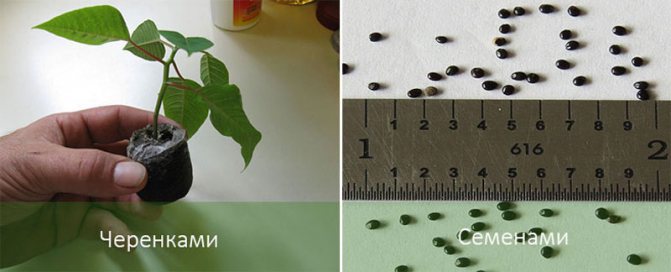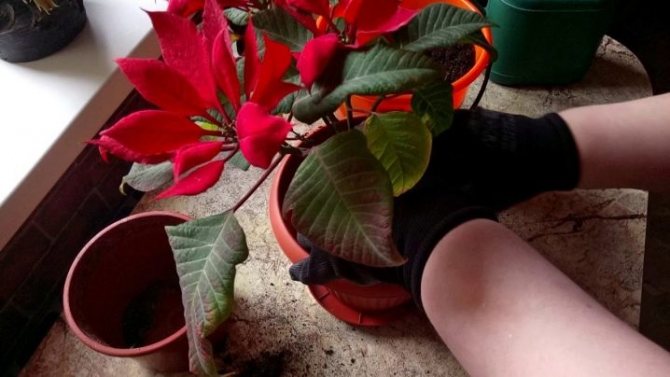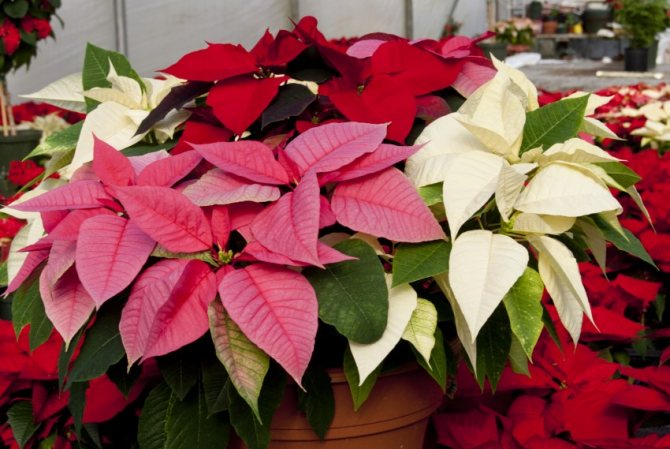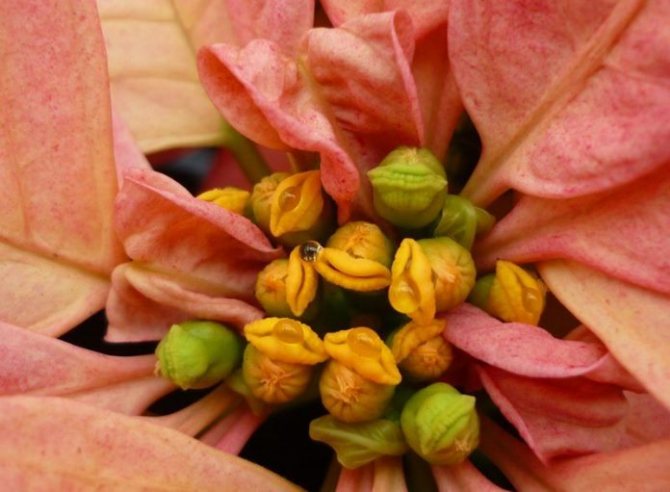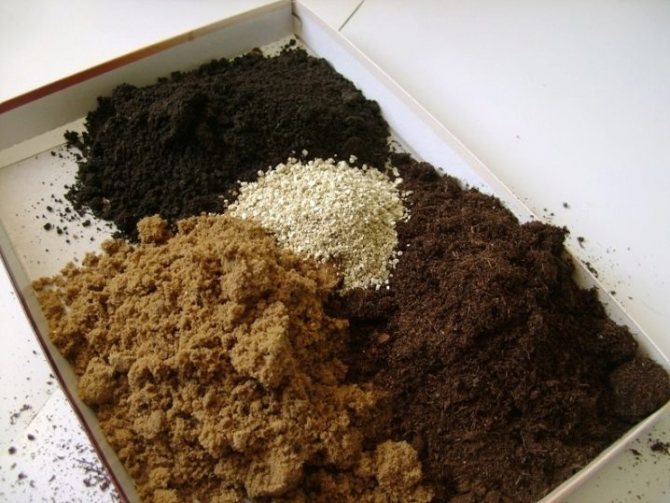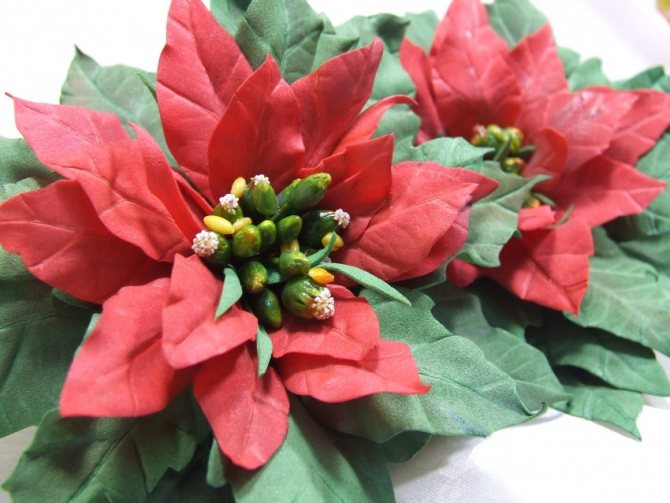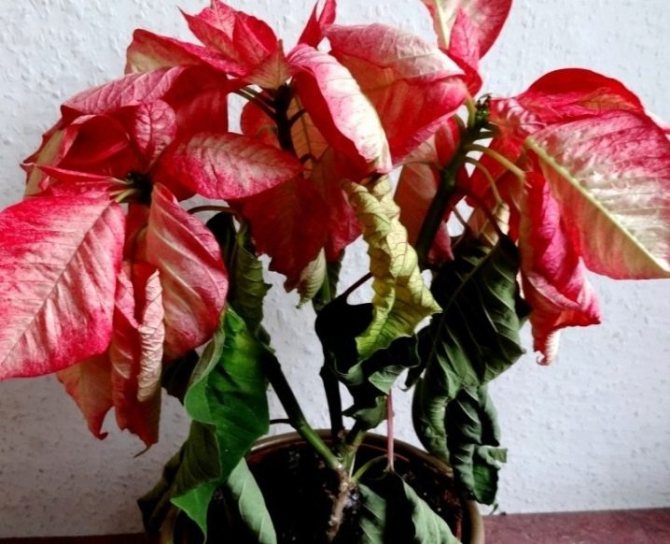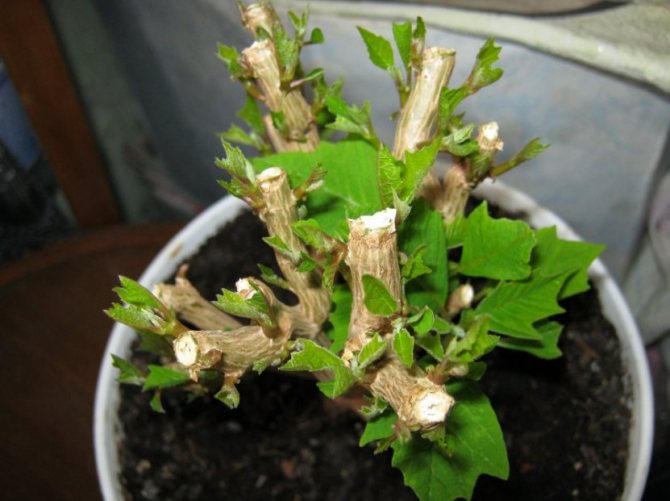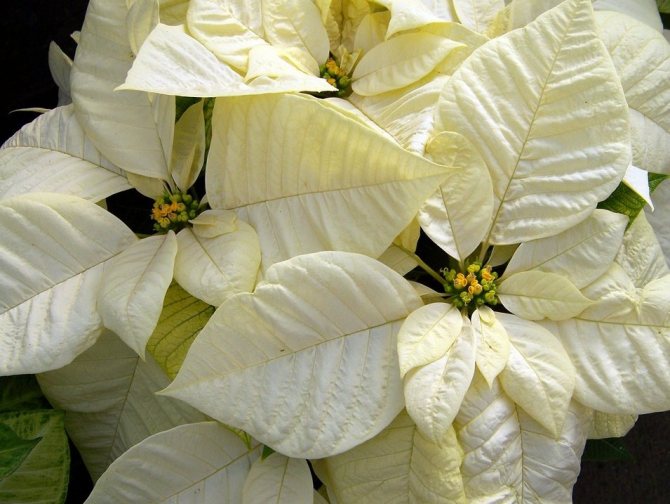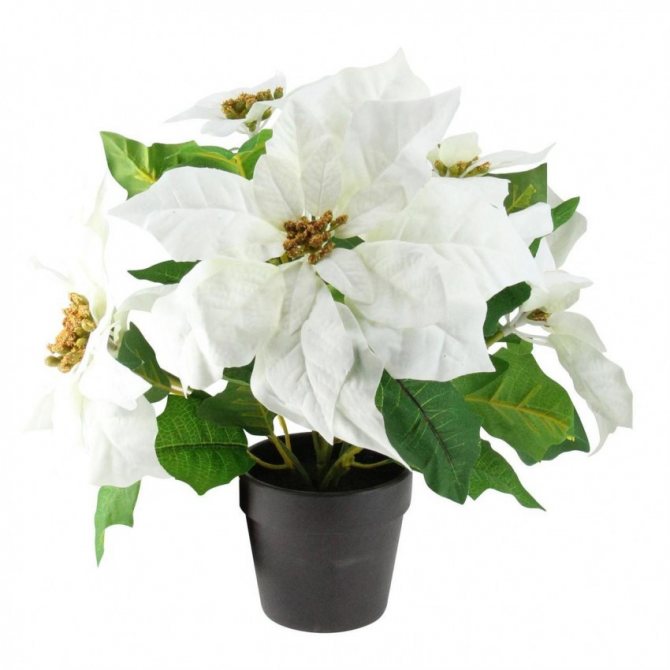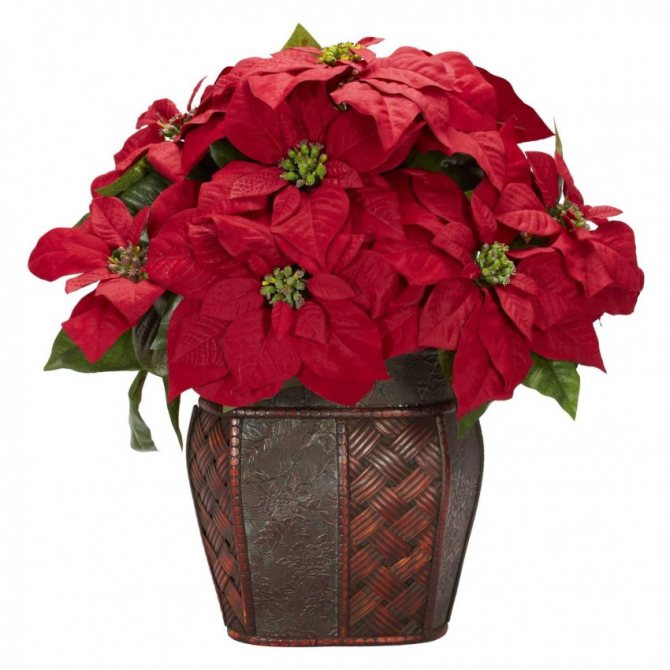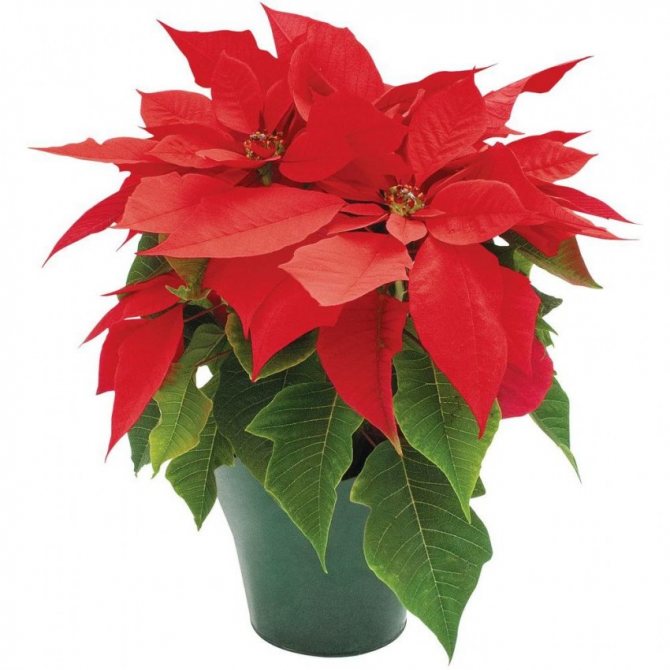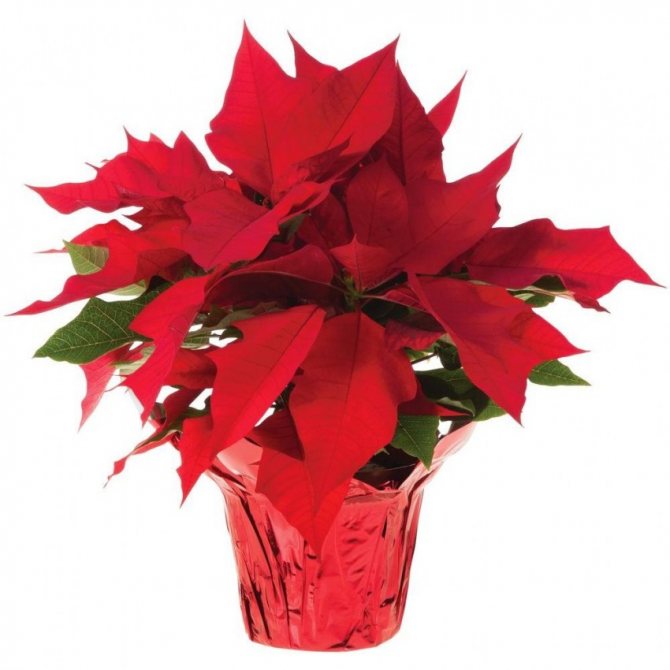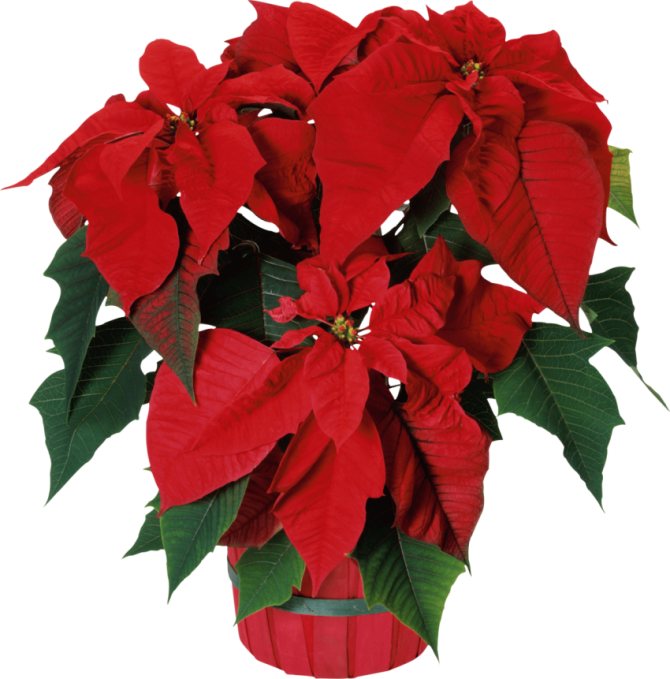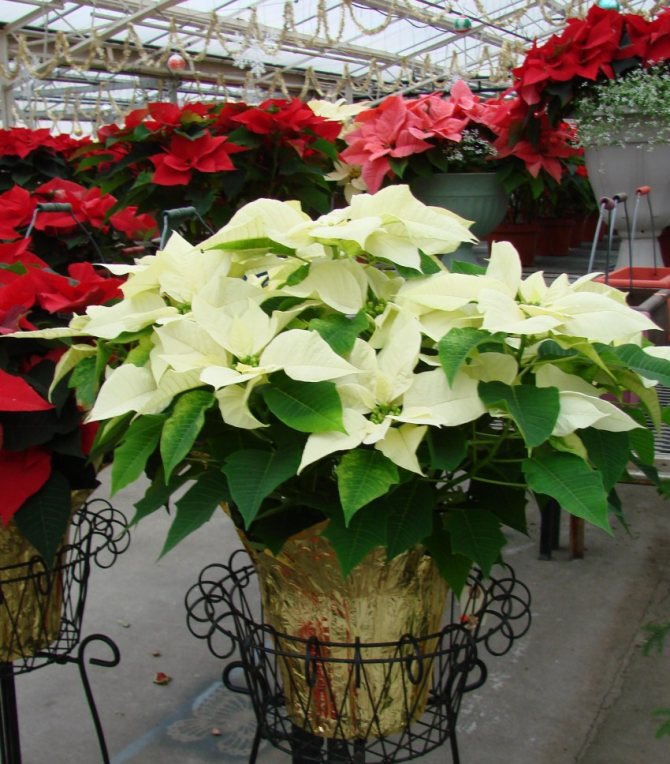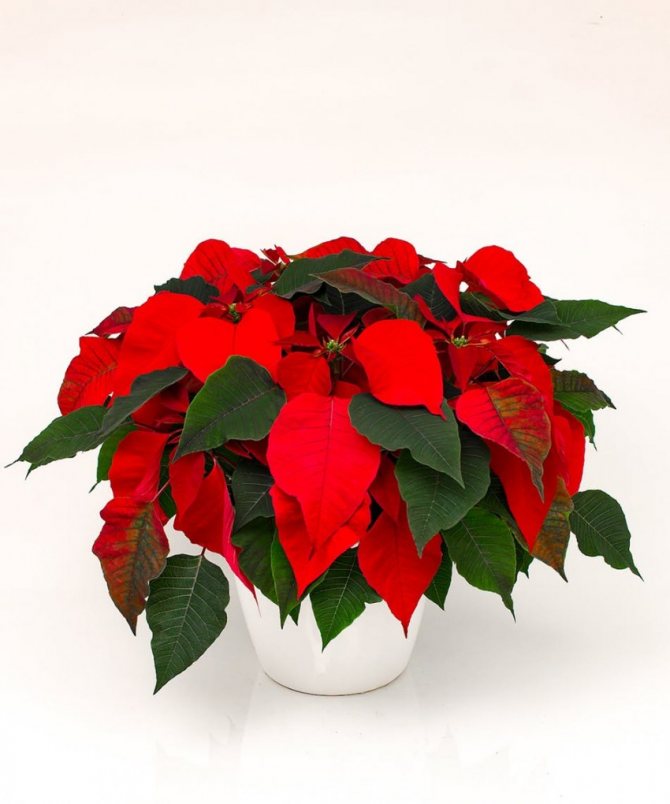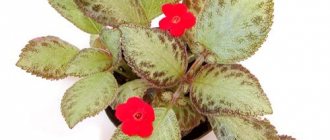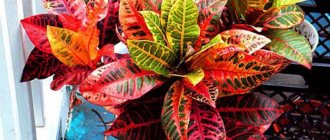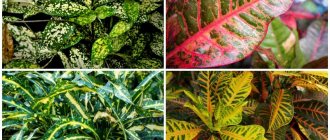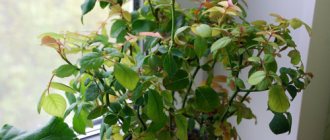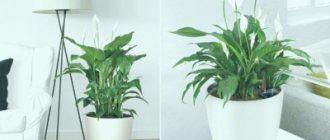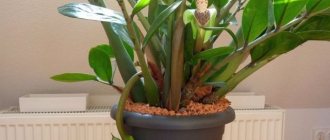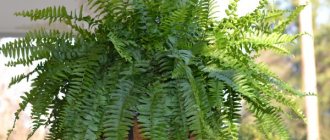It is easy to guess about the flowering period of poinsettia, knowing its middle name. Under favorable conditions, the plant blooms in late December or early January. Many people mistake the bright red stars towering above the green of the stems for flowers. And only attentive florists with experience know: the color of the poinsettia is plain and small. And the bright red something is the flowering leaves that frame a real flower.
What is the name of the winter flower? Another name for poinsettia is the most beautiful spurge. There are quite a few plant varieties, thanks to hardworking breeders. They did their best, showing the world not only the scarlet Star of Bethlehem, but also varieties with flowers of apricot, creamy and even spotted color. Botanists call the birthplace of poinsettia Mexico. But today she is a true citizen of the world. You can see the Christmas star in winter not only on home windowsills. Designers are happy to decorate shop windows and tables in cafes, restaurants and pubs with poinsettia pots. The plant is able to transform the atmosphere in the room, giving everyone around a festive mood.
One of the legends associated with poinsettia says: the girl, who learned about the birth of Jesus, wanted to give the baby a gift. For lack of money, she brought a bouquet of field herbs to the manger, which at the same moment turned into a beautiful flower with a lush cap of red stars.
Poinsettia flower description photo
The evergreen poinsettia shrub belongs to the euphorbia family. The rainforests of Central America are its only natural habitat. Hiding under the shade of trees, the bushes of an adult plant reach 3 meters. Branched stems, bare at the bottom, arcuate curved. Luscious green of pointed leaves, crowned with large scarlet inflorescences in the shape of a star, in the center of which is a small rosette of yellow inflorescences. Flowering occurs: December - February.
The extraordinary brilliance of the bush gave rise to many biblical legends that gave rise to another name for poinsettia. During the birth of Jesus, beggar children brought bare branches of a bush to the baby's cradle, blossoming with red stars in the morning, people named the flower "Star of Bethlehem" or "Flower of the Holy Night", since then they began to use it for festive decoration of the altar.
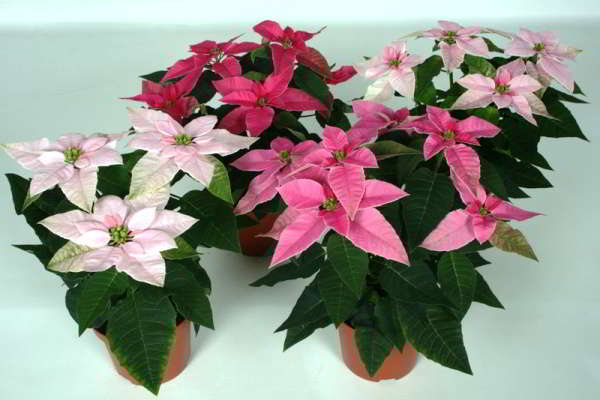
In the United States, the plant appeared two centuries ago thanks to D.R. Poinsett, the American ambassador to Mexico, a lover of botany, a cultivated species is named in his honor. He charmed the flower to Europe with the help of Albert Ecke, who grows on his ranch and supplies the famous "stars" for Christmas. Now the whole world has the opportunity to combine New Year's tinsel with the charm of a living flower, making the holiday inimitable.
The cultivated plant is a small (30 - 40 cm) decorative indoor bush. Erect stems have dark green leaves, petiolate, pointed, oval in shape with a serrated edge, 10-15 cm long. The flower is a rosette of small, green-yellow inflorescences surrounded by large expanded bracts, of unusually bright color. The scientific name is "Poinsettia the most beautiful" or "Euphorbia the most beautiful".
Breeders are working to improve the endurance of the plant at home, resistance to diseases, pests, trying to diversify the color of stipules. Bred varieties with white, purple, pink, cream and their shades; multi-colored, double (resembling roses) stipules.
New varieties have stems of various heights from dwarf to half a meter; not only green, but also edged leaves; both perennial plants and one, two-year-olds. All this variety is supplied to our store.
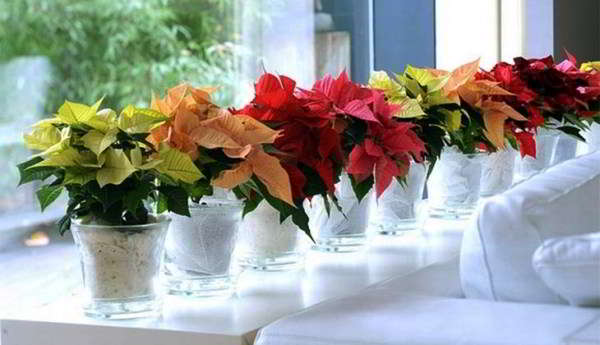

Interesting! The Aztecs associated the Star of Bethlehem with purity, used milkweed juice to treat bodily ailments, dyed fabrics with scarlet stipules, and used dye in tattooing.
Growing problems
When buying poinsettia, you need to hope for the best, but prepare for the worst. The flower is very demanding. Therefore, flower growers often face simple and not very difficult problems of growing it.
Diseases
Any violation of the rules of care entails the "whims" of the Christmas star. The table shows the most common diseases with an indication of the reasons for their occurrence. If you identify similar symptoms, your task is to provide the plant with prompt treatment, acting on the contrary.
Table - What and why poinsettia is ill
| Symptom | Cause |
| Inflorescences turn pale | - Excess moisture |
| Leaves turn yellow | - A flower pot installed in a draft |
| Foliage falls | - Rotting root system due to excessive watering |
| Infrared leaves do not turn red | - There was a violation of the rest period |
Don't be alarmed if poinsettia (bright, flowering leaves) turns green. This is evidence that the flowering period is over. After greening, the leaves will turn pale, and then completely fall off. This is normal. If it is time for the plant to bloom, but it does not bloom, it means that in the recent past you could not properly organize a rest period for it. Sometimes the lack of flowering indicates that the florist has confused the feeding and is giving the Mexican fertilizer for growth.
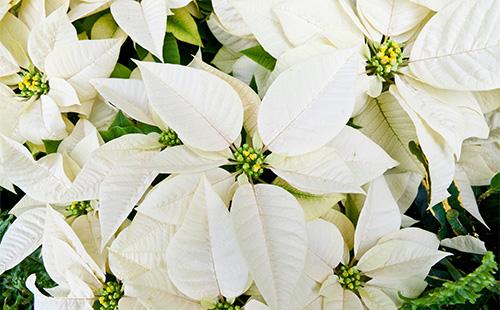

Pests
Violation of the rules for caring for a flower can not only undermine the health of the plant, but also cause more serious trouble - insect pests. The table lists the worst enemies of poinsettia and the symptoms of defeat by them.
Table - Pests of the Christmas star
| Pest | Symptom |
| Spider mite | - A small red beetle appears on the back of the leaf plate; - the sheet plate is enveloped in cobwebs |
| Mealybug | - There are "cotton" formations on the leaves and basal stem; - foliage turns yellow |
| Shield | - Brown plaques appear; - foliage falls |
| Thrips | - Leaves curl; - wavy lesions appear on the leaf plate |
| Gray rot | - Gray spots appear on the lowermost sheet plates |
Small amounts of pests can be removed by mechanical cleaning. Simply rinse a sponge in clean water and thoroughly wipe each poinsettia leaf free of pesky petty invaders. For greater persuasiveness, wrap the pot in plastic and thoroughly rinse the plant in the shower, thoroughly rinsing the foliage, including from the back. If this does not help, use insecticides after consulting a flower shop employee about diluting the medicine.
If affected by gray rot, diseased leaves should be broken off and discarded. After mechanical treatment, the flower must be treated with an antifungal agent and left alone.
Growing poinsettia at home is not an easy job. But the result is really worth it. For compliance with the rules of care and care, the Mexican beauty will repay you with a gold coin. She will bloom magnificently by the very eve of Christmas and will remain in her ardent outfit until March 8th.In the meantime, you can not only admire its flowering, but also actively use poinsettia as a living decor. A planter with red stars towering over dense green foliage will perfectly fit into the interior of a living room decorated for the New Year or find its rightful place at the head of the Christmas table.
Watch the video on how to grow a Christmas flower correctly.
How to choose the right flower when buying
Short daylight hours, lack of sunlight force indoor plants to remain dormant. Poinsettia, a tropical shrub, has retained the bloom characteristic of wild relatives in the winter months, appearing in our stores in late autumn, brightens these gloomy days with exotic splendor.
You can buy a plant only in specialized stores, where the air temperature corresponds to the conditions of keeping this particular species, it must be above 15 degrees, otherwise there is a risk of getting a flower with frostbitten roots, eventually an unviable plant. You need to pay attention to some details:
- Lack of packaging (the flower should be clearly visible).
- The potting medium is moderately moist (excessively wet or dry is evidence of inadequate maintenance, may affect the life cycle of the Christmas star).
- Stems - evenly colored, without black, brown spots, firmly rooted with the ground; leaves are present on all sides of the stems, bright green, without signs of wilting, disease, insect damage.
- The bracts are clean, not pollinated with pollen (signs of yellowness, the presence of pollen indicate a long-lasting flowering).
- Flowers should be greenish-yellow in buds (blossoming inflorescences will soon finish flowering).
If the Christmas star matches the one described, you can safely buy, the presence of any discrepancies - it is better to refrain from visiting another store, otherwise the purchase will turn into a tragedy. Open markets, unheated pavilions, do not correspond to the content of potted flowers.
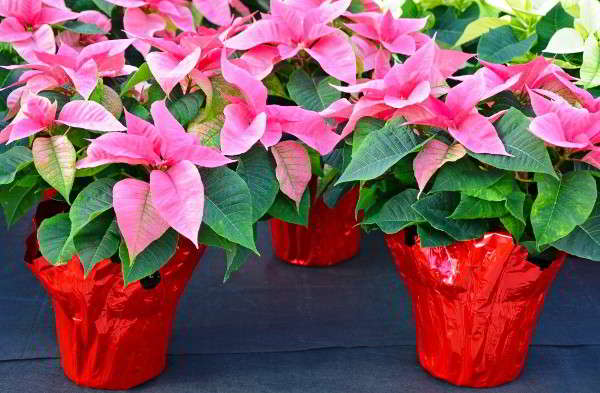

Reference! Despite the fact that poinsettia belongs to the poisonous genus of milkweed, there is no danger to pets. People who are allergic to latex need to be careful, the milky sap of the plant causes skin irritation.
Signs and superstitions
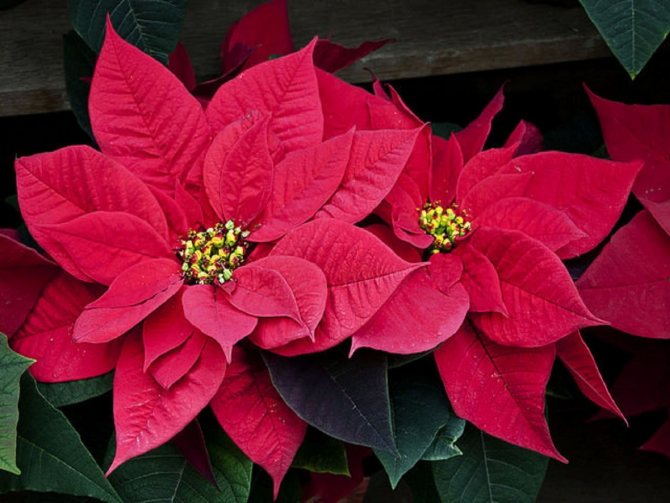

Poinsettia was brought to Europe from Central America. There, an evergreen shrub from the Euphorbia family reaches a height of 4 m. It looks especially beautiful during flowering, when bright red bracts appear on it, surrounding modest flowers. They resemble a star and look especially impressive against the background of rich green foliage. Another name for the poinsettia flower shown in the photo below is "Christmas star". So it was named for the shape of the bracts. In addition, they appear and delight with their flowering just in time for the Christmas holidays.
On a note!
In Europe, it is customary to give poinsettia at Christmas. It is believed that the plant protects the house from ill-wishers. It relieves the owners of quarrels and troubles, brings harmony to relationships, calms the nervous system and relieves stress.
Many esotericists claim that the most beautiful euphorbia has a strong healing effect, improving the interaction of the cerebral hemispheres. Its positive energy promotes the disclosure of talents and reveals the ability to learn. Some believe in the magical ability of poinsettia to lose weight by speeding up the metabolism.
How to transport a flower in winter
Winter in the northern hemisphere is a harsh time of the year. Tropicana poinsettia does not tolerate a sharp drop in temperature. Only careful packaging can save the bush from the cold during transportation.
The Christmas "bouquet" is wrapped in several layers of thick wrapping paper, carefully without pressing the bracts, the delicate fabric easily wrinkles, loses its decorative effect (you can use the box), then wrap it with a cloth. It is advisable to keep it in the cold as little as possible. Immediately unpack the Tropicana brought to the house.
In open ground
For the summer period, many growers prefer to plant a flower in open ground. Until about the beginning of autumn, the poinsettia can be outdoors. Transplanting to a flower bed is carried out as follows:
a plot on the south side is selected;
the soil is fertilized with any mineral mixtures for flowering plants;
by transshipment, the bush is transplanted to the desired place.
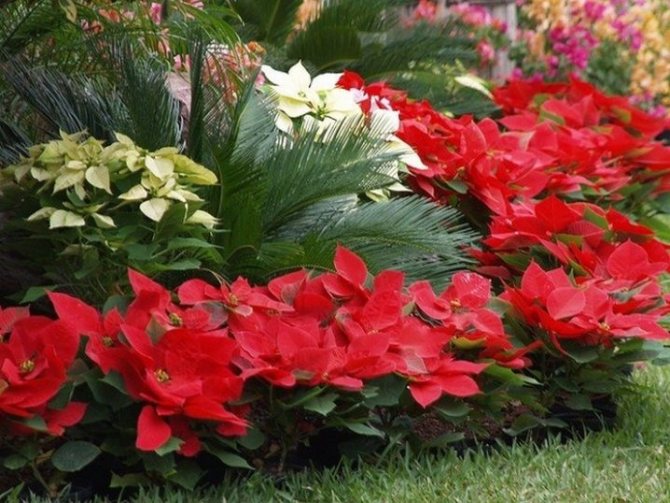

Growing crops in the open field in summer has its own characteristics. For example, fertilizing is applied twice a month, and watering is carried out only in moist soil, otherwise the roots may get burned. At the same time, it is important not to overflow the culture.
The plant transplanted to the site also needs to be covered with a transparent cap. In addition, gardeners recommend using a slow-release fertilizer when growing, so maintenance will be much easier.
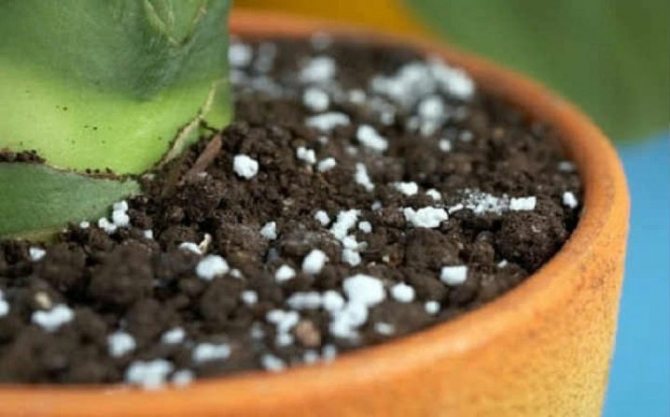

After transplanting, it often happens that the bush does not take root in a new place. Perhaps the reason lies in trauma to the root system during transplantation or in the formation of putrefactive processes. In these cases, the “moving” procedure needs to be repeated, and before that the roots should be lowered into “Kornevin”, this composition will ensure the correct development of the root system. If the flower failed to revive, then you can try to grow a new shoot from the cuttings.
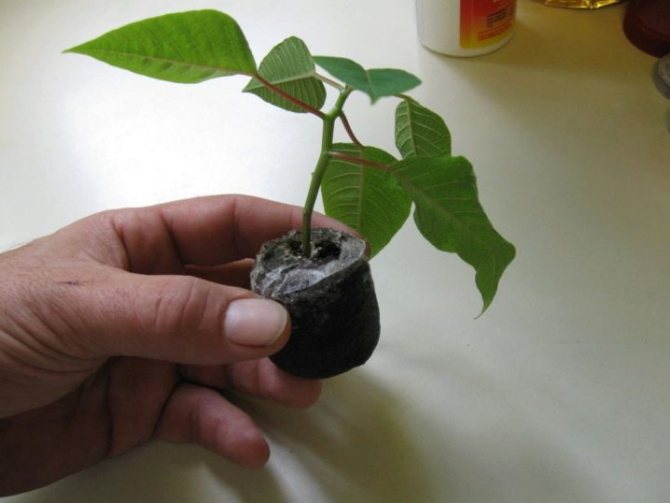

Another reason for poor adaptation of the culture to new conditions may be non-compliance with the rules of care. Experienced flower growers give advice on how to properly care for poinsettia.
Pay special attention to lighting. Under the influence of direct ultraviolet rays, burns can form on the leaves, the brightness of the flowers is lost, sometimes after such exposure, the previous colorful color is not restored. Therefore, it is recommended to place a container with a plant on the east or west side. It is important that the light is diffused, so it will not be superfluous to stock up on additional devices. Also, a special phytolamp will be able to help out the florist.
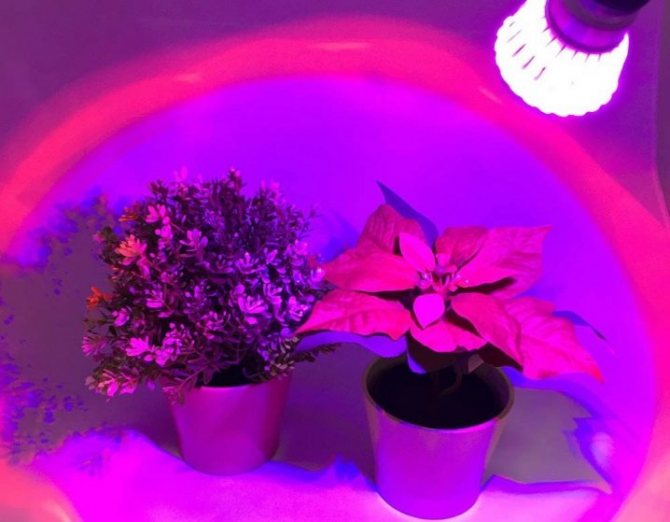

It is important to monitor the humidity of the air. For good development, this indicator should be observed within 60-70%. Daily spraying of the aboveground part will help to ensure a favorable level of humidity. Another option is to place a container of water near the pot: a decorative fountain or a household air humidifier.
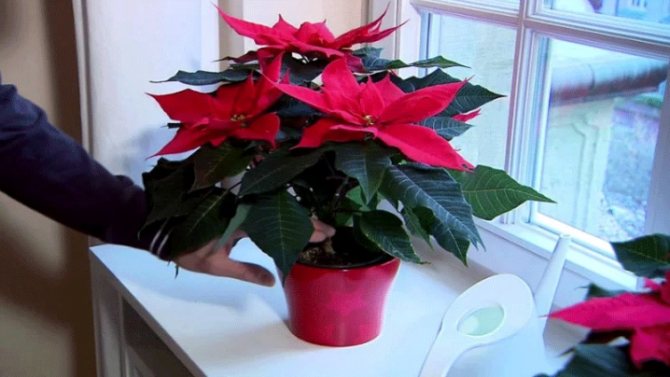

Another rule is to avoid sudden changes in temperature. The constant temperature should be limited to 16-27 degrees above zero. The most comfortable temperature range is 20-24 degrees.
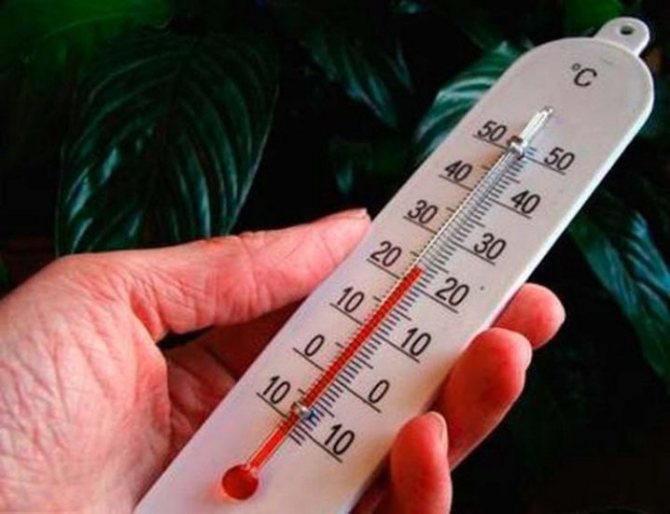

An important period in the life of a plant is flowering. During this state, it is not recommended to replant the poinsettia, you must wait until the specimen has faded. The favorable temperature during the rest period is from 12 to 14 degrees.
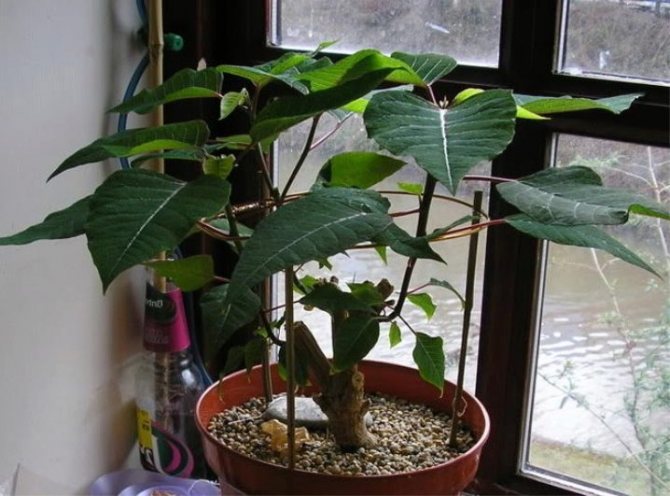

Be sure to follow the rules of watering. In summer, the procedure should be carried out often, the amount of water is abundant. It is important not to dry the ground. In winter, watering the plant is enough once every 3-4 weeks. At the same time, the water must be clean and settled, its temperature is 30 degrees. Heating water in a microwave oven or on a stove is allowed.
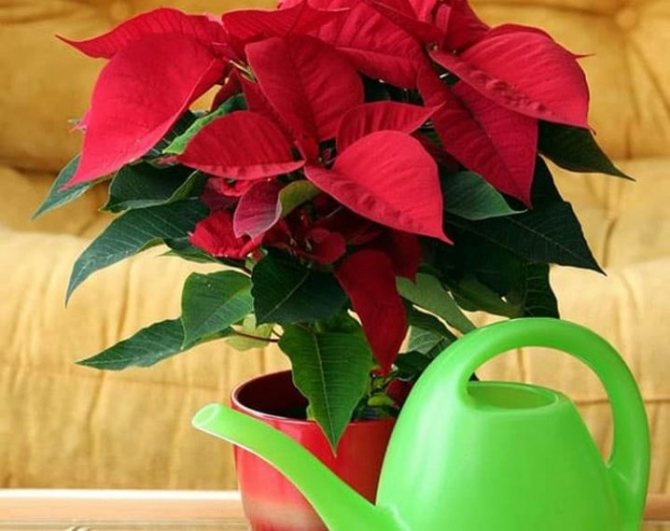

The flower cannot be fertilized immediately after transplanting. The rest of the time, the plant needs feeding. After flowering, fertilizer is applied a maximum of once a month. In spring and autumn, mineral complexes are suitable for this, in summer it is recommended to use a weak mullein solution, and in winter you can use a potassium mixture for ornamental houseplants.
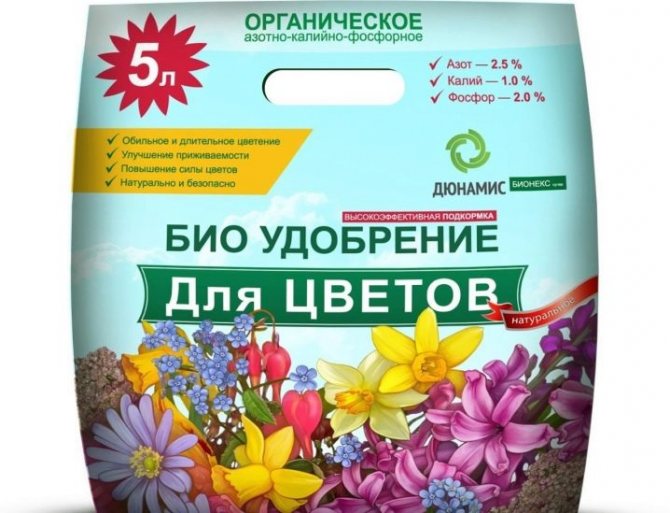

Flower pruning is done immediately after the flowering period. The growth of poinsettia is quite intense, and therefore it needs pruning in March-April. At the same time, the stems are eliminated, only decimeter green rods remain in the pot. The pruning procedure ends with watering and abundant spraying. After 1-1.5 months, new shoots begin to hatch, of which no more than 6 of the strongest should be left, and the rest should be removed again. By the way, cut shoots can be rooted in the ground, thereby multiplying the flower.
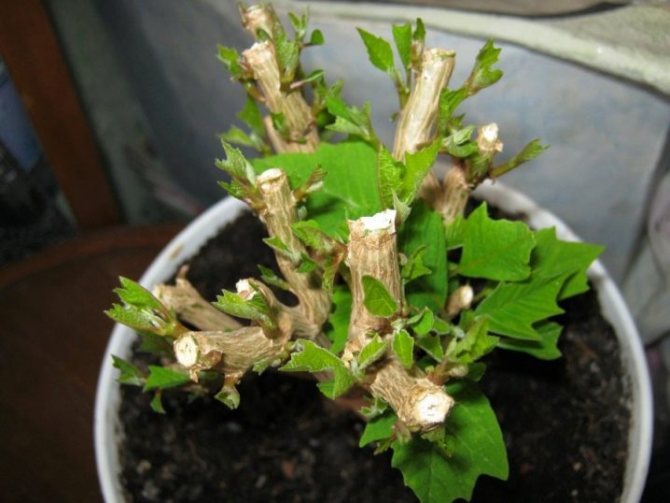

Poinsettia after purchase initial care
It is preferable to purchase the Star of Bethlehem for a home collection in advance, while the plant does not bloom. Purchased in a store, it requires gentle, specific care.
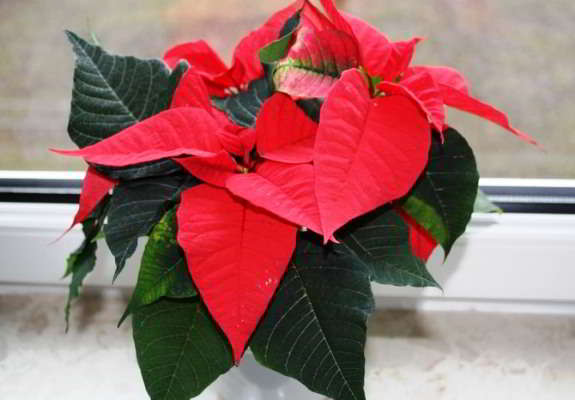

A tropicana brought to the house, unpacked (flowering or just about to be) is put into "quarantine" - a place far from other plants and most comfortable for a beginner. Poinsettia, although a Christmas star, is still a tropical plant with its own requirements. She can't stand:
- direct sunlight, preferring diffused light;
- cold glass of the window, the leaves immediately freeze, darken;
- drafts and cold air from the window have a detrimental effect on growth;
- dry, hot air emanating from the batteries will destroy the bush.
Given these requirements, having determined a place for it, it is advisable not to touch it for about 3 weeks. During this period, the milkweed is being adapted to a new place of residence. It is enough to make sure that the soil does not dry out, maintain air humidity, and provide 8-10 hours of lighting.
Attention! By increasing the humidity of the air by spraying, it is necessary to protect the flower, from the direct hit of water drops on the stipules - spots are formed, decorativeness is lost.
The flower is problematic - no doubt
When growing poinsettia, problems may arise, the reasons for which and their solution should be known to every grower:
- Leaves turn yellow and fall off... Reason: non-observance of the temperature regime in the room. Severe temperature fluctuations negatively affect the plant, therefore poinsettia should only be kept in rooms with a constant microclimate.
- Burn marks appeared on the leaves... Reason: direct sunlight at lunchtime. To avoid damage, the bush is removed to a shaded place.
- Roots rot... Reason: excess moisture in the soil. To prevent the root system from rotting, excess water is drained from the pan. It is possible that unsuitable soil is trapping moisture.
- Traces of pests are visible on the leaves... Reason: the plant is affected by a spider mite or scabbard. At the first signs of development, the plant is cleaned with a soapy sponge and washed under the shower. The surface of the pot can be covered with plastic wrap.
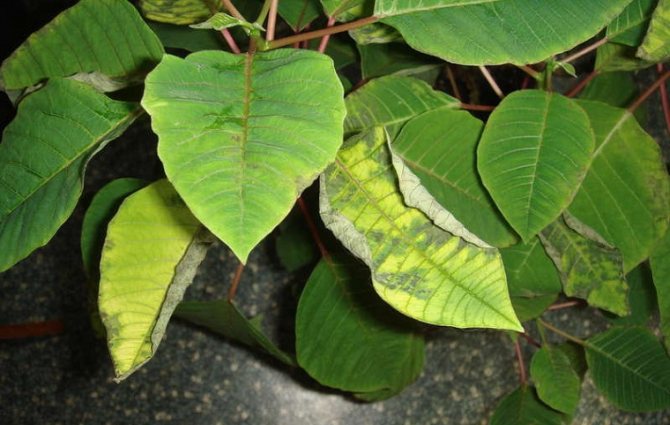

Why poinsettia does not bloom
Most likely, this or that recommendation was missed during the preparatory period.
Only with perfect observance of the temperature, light, watering regime can the plant re-flowering be achieved.
When to transplant a flower after purchase
After 3 weeks of adaptation, the bush should be transplanted. The shipping soil in which it is sold is inert, contains a large amount of fertilizers, stimulants, hormones, but there are no trace elements to maintain healthy growth, the substrate must be replaced.
The poinsettia left for a long time in such soil will die. If the plant has bloomed, transplanting is not recommended, you will have to wait for the end of flowering, otherwise the tropicana will drop the leaf. During this period, feed every 2 weeks with fertilizer for flowering indoor plants.
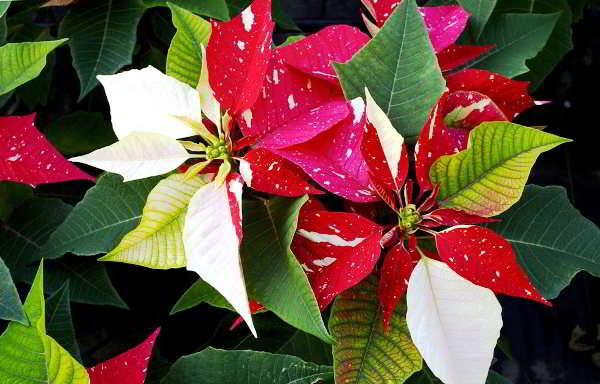

Continue watering with settled water, maintain temperature, humidity, and provide adequate lighting. A non-blooming Christmas star must be transplanted.
Advice! Water the poinsettia with settled water, the temperature of which is 2 degrees higher than room temperature.
Species composition
The Christmas flower owes its attractive appearance not so much to the flowers themselves, rather faded and inconspicuous, but to the bracts.
Poinsettia is the only species in this genus, but quite a few varieties have been bred. Today, plants are sold with bright red, burgundy, pink, yellow, snow-white bracts. The flowers themselves are inconspicuous, even without a calyx and corolla.
But at the end of flowering, the leaves become pale and gradually fall off.
For several weeks, the plant rests and recovers, therefore it needs special climatic and vegetative conditions.
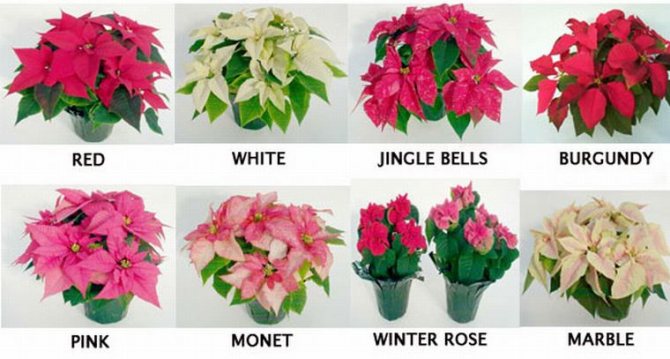

Varieties of poinsettia
Poinsettia transplant after purchase
Poinsettia primer prefers light, neutral, breathable. A combination of clayey sod, leafy soil, peat and sand (taken equally) is most suitable. The roots of the Christmas star are moderate and delicate, so the flowerpot should be small, of the same width and height, taking into account the further growth of the roots until the next transplant (2 - 3 years).
When transplanting, any plant experiences a shock, so all actions are performed with extreme caution.
Remove the euphorbia from the pot, immerse it in a container with warm water, soak it so that, when removing the soil, injure the roots to a minimum. Prepare a pot for planting by sprinkling drainage on the bottom (1/3 of the container).
Stir the constituent parts of the earth, pour over the drainage to half the flowerpot. Remove the bush from the water, freeing the roots from the soaked earth.
Rinse them under running water, washing off the remains of the soil (the surviving particles may contain grains of concentrated fertilizers that are dangerous for the root system).
Examine the roots for damage - rotten, cut off the wounded with a sharp knife. Sprinkle roots with a growth stimulator "root".
Place the poinsettia in the center of the pot, straighten the roots, cover it tightly with earth, checking that there are no voids.
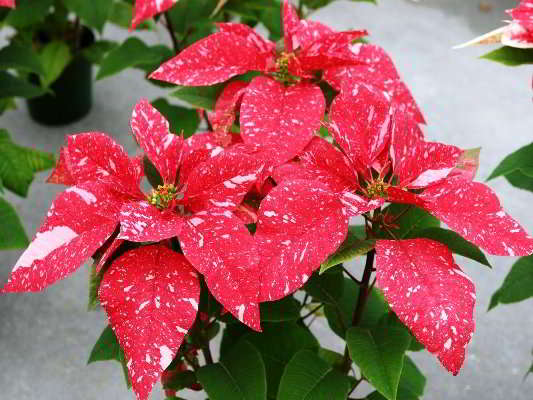

Finally, spill with warm, settled water. Put the spurge in the place intended for it. Provide a comfortable temperature, air humidity, lighting. Watering when the topsoil dries out; it is imperative to drain water from the pallet after watering.
The first feeding can be done only after signs of poinsettia growth (the appearance of sprouts, leaves), after about 1 - 1.5 months.
Advice! If there are difficulties with choosing the size of the pot, there is a rule: the diameter of the pot is equal to the diameter of the crown of the plant at the time of transplantation, the exceptions are those who prefer only tight flowerpots - succulents, cacti, epiphytes, hoya and some others.
Planting and transplanting a plant
The old plant should be transplanted from mid-spring to May, at the same time pruning is carried out, rejuvenating the poinsettia.
Rooted cuttings are planted in early summer (in this case, cuttings are carried out at the end of April - May).
The optimum temperature for landing is 20 ... 22 degrees. To make planting easier, the plant needs diffused light and very high humidity (about 90%) during rooting. After a couple of weeks, the plant begins to grow, and the foliage becomes dense, elastic.
The flower feels most comfortable with an average acidity of the soil - 5.8 ... 6.6 pH. To provide this level, the soil is created from 3 parts of leaf and turf land, 1 part of sand and peat.
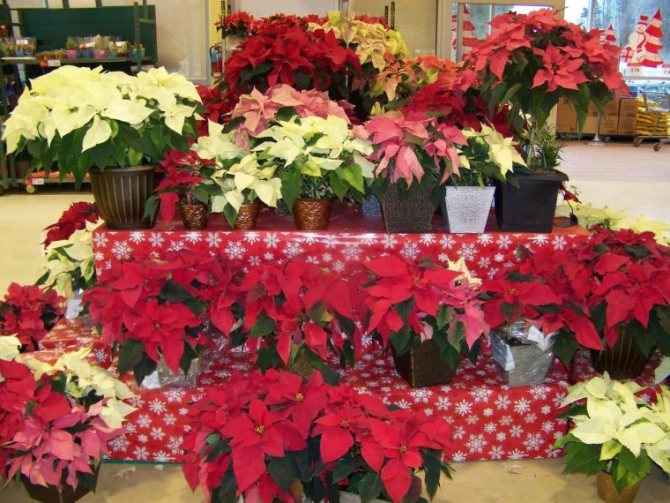

How to transplant a plant after purchase?
After the poinsettia has got used to the new conditions in the house, it must be transplanted.
Usually, the full habituation of the flower takes three to four weeks.
The flower is transplanted into the soil using the transfer method, the composition of which is indicated above, it is also necessary to add vermiculite.
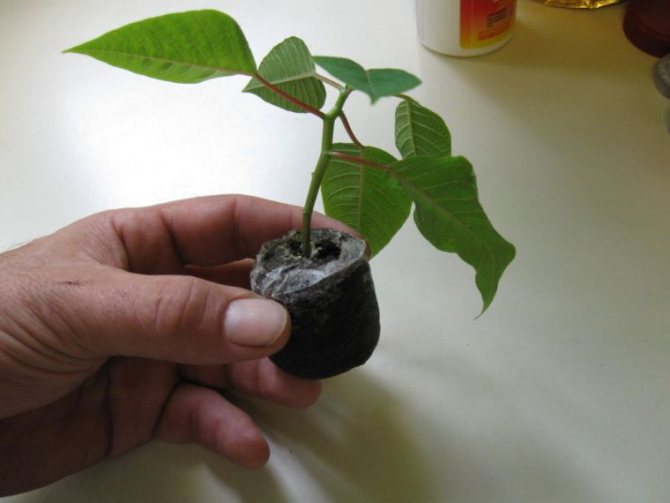

Poinsettia transplant after purchase is a mandatory procedure
An important condition: there must be drainage in the pot, which will help to avoid stagnation of moisture in the soil.
Subject to a number of transplant rules, the Christmas flower will bloom until March.
Annual transplant
A flower that has come out of dormancy is transplanted at the end of spring. This requires a capacity slightly larger than the previous one. 3-5 cm of drainage is laid under the main soil layer.
The plant is cleaned of rotten and old roots, after which it is planted in prepared soil. A bag is put on the pot: this is necessary for the formation of a mini-greenhouse.
In order to ventilate this "greenhouse", the film is removed for half an hour. It is important to ensure that no condensation forms on the walls. After one month, the package can be removed.
How to care for a Christmas star flower to bloom for a long time
The charm of the Star of Bethlehem will not leave anyone indifferent. Bright colors of a tropical beauty favorably affect the emotional state of a person, cheer up, bringing in positive notes of festivity and pleasure, so necessary for a long winter.
A fairly long flowering period is ensured by the correct, nurturing maintenance of the poinsettia. The warm, moderately humid atmosphere of the room, the average duration of lighting (everything that is needed for a comfortable stay of a person) will be gratefully accepted by the poinsettia.
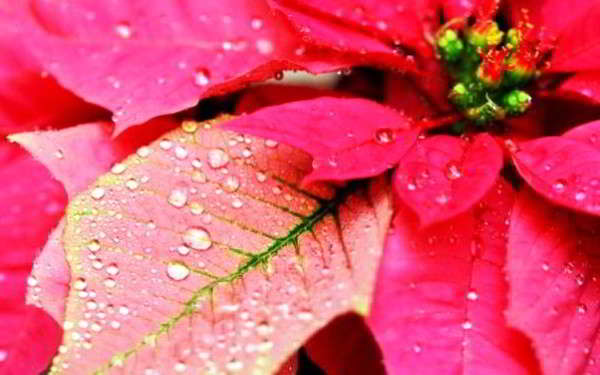

Timely watering, competent feeding will give vitality. The grateful South American beauty will delight you until spring. For re-flowering, like any houseplant, the Star of Bethlehem must adhere to the growth stages.
Rest
The rest phase lasts from February to March. After flowering, the remaining leaves are removed, the stems are cut, leaving 2 growth buds (about 10-15 cm from the soil level), the cuts are treated with crushed charcoal, sprayed with insecticide to prevent diseases (the soil too).
The plant is removed to a cold floor or transferred to a shaded, cool room. Leave minimal watering (so that the flower does not die from drought), air humidification is not required. The flower rests for 2 months.
Vegetation
After relaxation, the poinsettia is transferred to a lighted warm place (any window sill, the early spring sun is not dangerous), abundant watering and humidification of the air begin. Regular feeding with complex fertilizers with a high nitrogen content will allow the shoots to grow faster.
After a few weeks, re-cut the regrown stems, leaving slightly stronger ones (3-4). Further content includes the regular continuation of procedures that support growth.
In the summer, take the plant out into the air, protecting it from direct sunlight. Monitor the state of the substrate, water and feed on time. To form the crown of the bush by pinching the tops, the sprout that appears after 5 or 7 leaves is removed. The optimum temperature is +20 +25 degrees.
Budding
The most responsible and laborious period, beginning in September, lasts 8 - 10 weeks. Poinsettia is a photo-dependent plant. Its flowering completely depends on the duration of the daily rhythm of illumination, therefore it is necessary to arrange dark nights for it.
The unattainable light period should be 14 - 16 hours. At this time, close the flower with a cap from an impenetrable black bag, a cardboard box, or use a closet, pantry. Such manipulations are carried out before the stipules are stained, the buds appear.
At the same time, feeding with fertilizers containing a large amount of phosphorus, potassium, but reduced nitrogen.
The entire period of budding - moderate watering with warm, settled water (without flooding the plant, draining the pan), humidifying the air. Indoor air temperature + 18 + 20.
Bloom
The appeared buds signal the end of the preparatory period. Light limiting activities end, on the contrary, the blooming Christmas star prefers bright lighting.
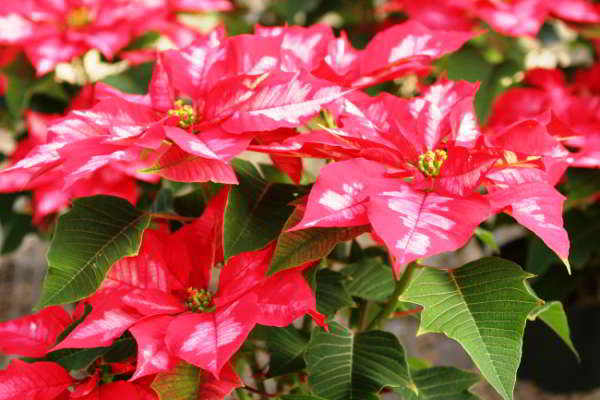

On a cloudy day, artificial lighting is needed.Regular watering, fertilizing with mineral fertilizers for flowering indoor plants, humidity and heat conditions +16 - +18 will allow the poinsettia to feel comfortable for a long time. Pruning and pinching are the main factors that stimulate the growth and formation of the bush and deserve special attention.
Reference! The ratio between light and dark time of the day, affecting the transition of a plant from growing season to flowering, is called photoperiodism.
Trimming poinsettia at home
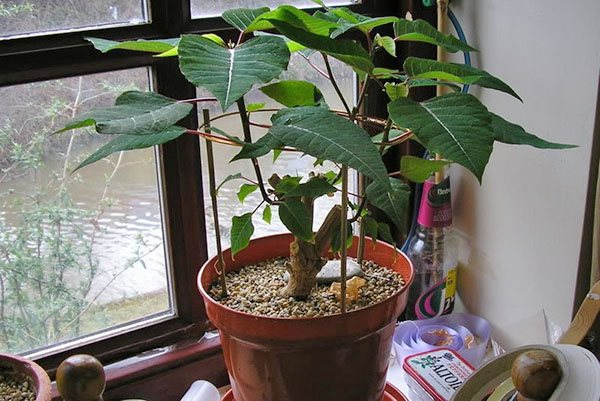

The first pruning of poinsettia after the purchase of the house is waiting for a flower after the bright deciduous rosettes have faded. Before the plant retires, it is cut off, leaving 3-5 healthy buds on each of the shoots. They will provide new growth and become the basis for future flowering. For rest, the poinsettia is transferred to a cool, dry room. At a temperature of + 14–16 ° C, under the scattered rays of the sun, the pot remains for 2 months.
As long as there are no signs of awakening on the stems, poinsettia practically does not need watering. If the soil is moistened, then very carefully to cause rotting of the roots and aerial parts.
In May, the resting period of the punsettia ends. The kidneys left behind are awakening. As soon as this happens, the pot is transferred to a warm, bright room and active watering is resumed, making sure that between the procedures the top layer of the soil dries out a little, and water does not accumulate in the pan under the pot.
In order for the flowering to be as lush and strong as possible, no more than 5-6 strong shoots should be left on the flower. In the future, the green parts of the flower can be pinched until August, when the rudiments of future inflorescences are laid at the ends of the shoots.
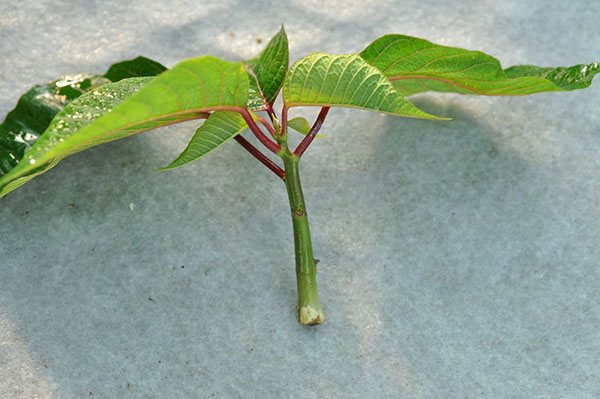

Parts of the stems that have become unnecessary after pruning, when the poinsettia is propagated at home, turn into excellent cuttings.
Diseases and insects - pests
A tropical beauty, like all euphorbia, rarely gets sick. Trouble arises solely from care oversights. The intolerance of the poinsettia overflow or dryness, unbalanced feeding, turns into a blow:
- discarded leaves;
- drooping, blackened stems;
- white spots of bracts;
- leaves turn yellow, turn brown, dry up;
- roots are soft, rotten;
- brown with light thin roots;
- rotten, bifurcate, exposing the core.
Irregularity, redundancy, lack of feeding, sudden changes in temperature and humidity, lack or excess of lighting, insect infection from neighboring plants - all this is a human factor, the treatment of which is the care and attention to the most beautiful Poinsettia.
To a greater extent, the sources of infection are bacteria or viruses that inhabit the substrate, carried by insects from neighboring plants. Living or getting into a damp, warm environment, they instantly multiply, affecting the roots, then the stems, leaves. It is difficult to recognize the pathogen at the initial stage. Looming obvious signs of the disease - the plant is already difficult to save. Possible diseases dangerous for poinsettia:
- gray, root, stem rot;
- powdery mildew;
- sooty fungus;
- rust and others caused by fungal spores.
You can try to save by drying the soil, cutting out all the affected areas of the roots and the ground part, sprinkling with copper sulfate, "Fundazol".
Advice! Dressing the soil before planting with a weak solution of potassium permanganate protects against many fungal infections.
Viruses carried by insects are also dangerous, arising from a violation of the heat and humidity regime, for example:
- Mosaic, from which the leaves are covered with yellow - green stains, over time, acquiring tuberosity,
- Wrinkling - growth slows down, decorativeness is lost.
- Jaundice - the vascular system is affected, chlorosis of leaves and stems with areas of necrotic tissue, deformation, ugliness of shoots. The treatment is not effective. The plant must be destroyed before the neighboring ones are infected.
Major insects that carry bacteria and fungal spores
The spider mite is the smallest individual that is difficult to eradicate; in a week it turns from an egg into an adult insect, gnawing out the tissues of leaves and stems; entangled in microscopic cobwebs, they become covered with yellowish (later brown) spots, crack and die off.
It lives on the inside of the leaf. Afraid of moisture, but even adapts to chemicals. Fitoverm is a safer insecticide for humans.
The mealybug is a winged aphid, the female lays up to 2000 eggs in “cotton” mucous lumps on the inner side of the leaf, the larvae spread throughout the plant, entangling them with sticky cobwebs (the source of the sooty fungus). Sucking out the juices of the plant, it dries up the leaves, growth is inhibited. Not afraid of water. Mechanical removal, Fitoverm.
Scale - flying males, females sticking to the surface of the leaf feed on sap, cover it with hard-to-separate "scales", the larvae leave a sticky trail as they move (a favorable environment for the development of fungi); the plant lags behind in development, the leaves become covered with brownish spots from a large accumulation of individuals, and fall off. Removal with a cotton swab and soap, treatment with an insecticide (universal).
Treatment of diseases is a troublesome and laborious business; problems can be avoided only by observing the rules for keeping pets, regular examination, and prevention.
Plant varieties
Today, more than 100 types of poinsettia are known. The most beautiful and popular are:
- Carousel pink - amazing pale pink color;
- Cortez fire - flowers of a rich red hue (even closer to burgundy);
- Freedom White - large white flowers;
- Gold tinger - the usual red color;
Note: most often found at home among amateur florists. - Jester pink - the flowers themselves are pale pink, with a greenish edging around the edges;
Note: considered the most fastidious species. - Jester red - deep red flowers with dark (almost black) veins.
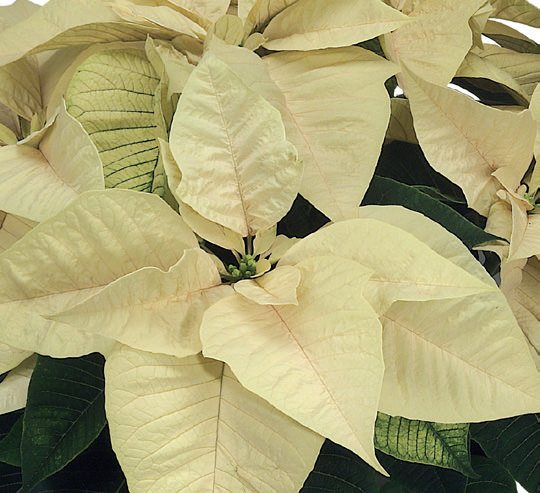

Freedom White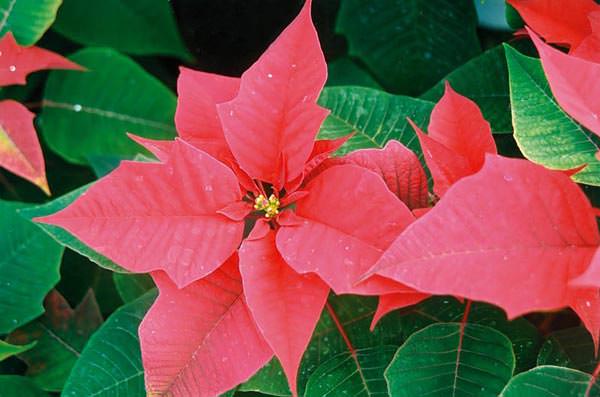

Gold finger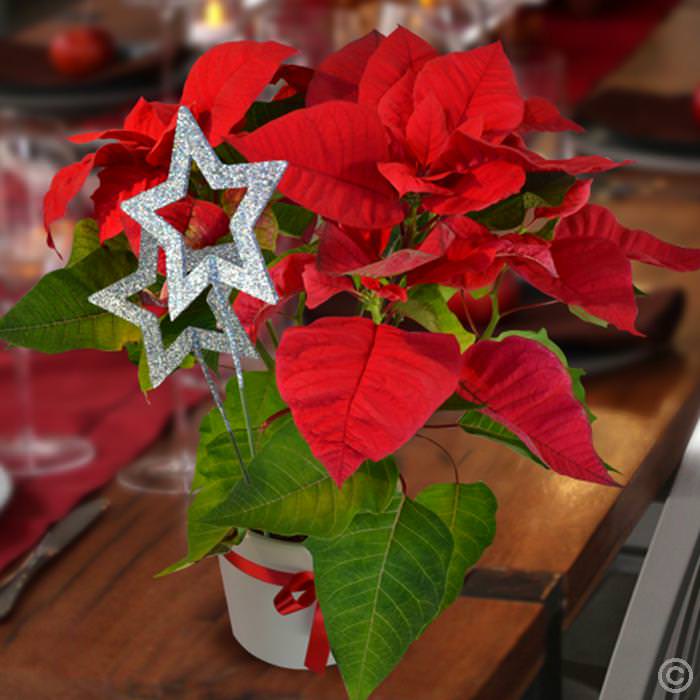

Jester red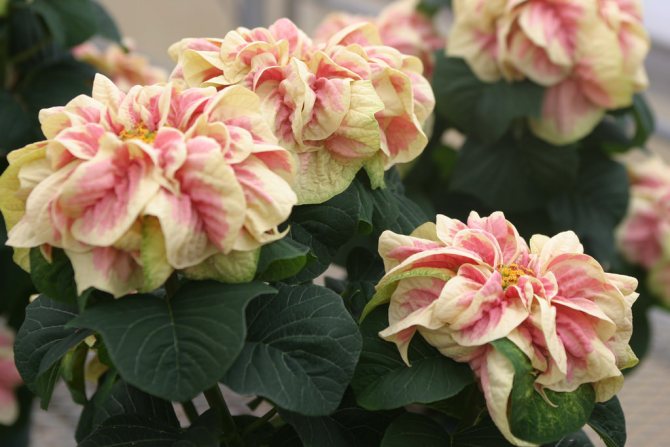

Winter rose early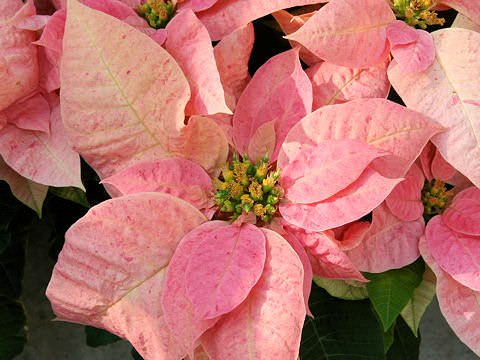

Amazon Peppermint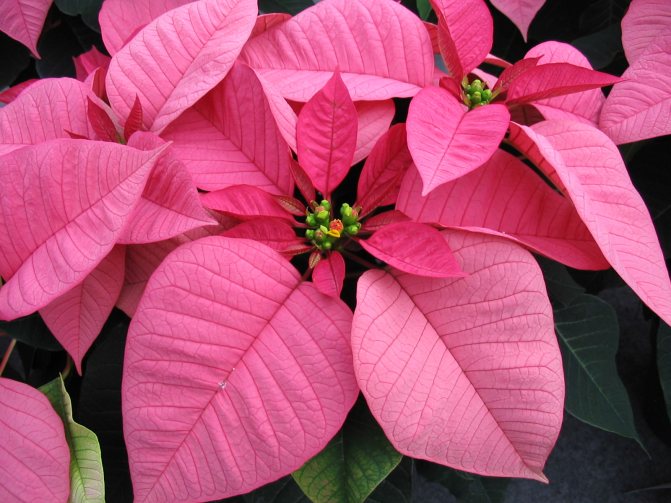

Pink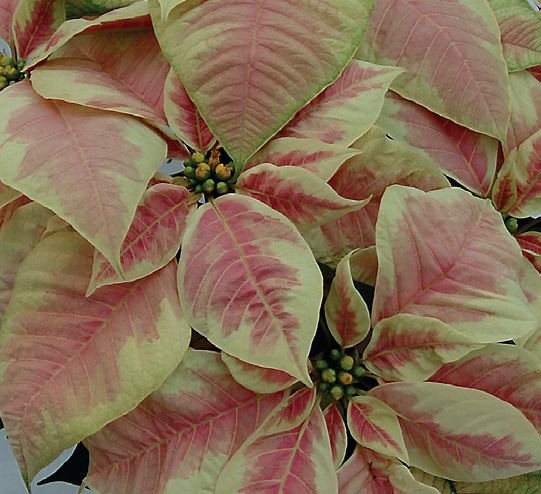

Stargazer marble
Poinsettia transplant
Timely transplantation is one of the preventive measures. The most favorable period is the beginning of the growing season, the emergence of new shoots. Method - transshipment - protects the tropicana from unnecessary stress, stimulates growth, is carried out annually.
A new flowerpot, with a large diameter of 1.5 - 2 cm, is filled with 1/3 of the drainage, a little fresh soil. Carefully removed from an old pot, the bush is placed on the ground, covered with the remains of the substrate, compacted, spilled with warm, settled water until the liquid appears in the pan (be sure to drain). Further care comes down to compliance with the life cycle regime.
We transplant step by step
When replanting a plant, follow the steps below.
Pick up a new flowerpot with parameters at least one centimeter larger than the previous one.
Place a 3 cm drain on the bottom. You can use gravel, expanded clay or pebbles.
Next, fill in the middle layer of the substrate.
Carefully remove the flower by transferring it from the previous container and place it in the prepared pot along with the earthen lump. Try to avoid trauma to the root system.
Fill in the remaining space with additional soil.
Place a transparent cap on top of the bush. This procedure is designed to provoke high humidity. Do not remove the cap for two months - during this time the roots have time to adapt to the new amount of soil. You need to open this shelter daily so that the earth does not rot.
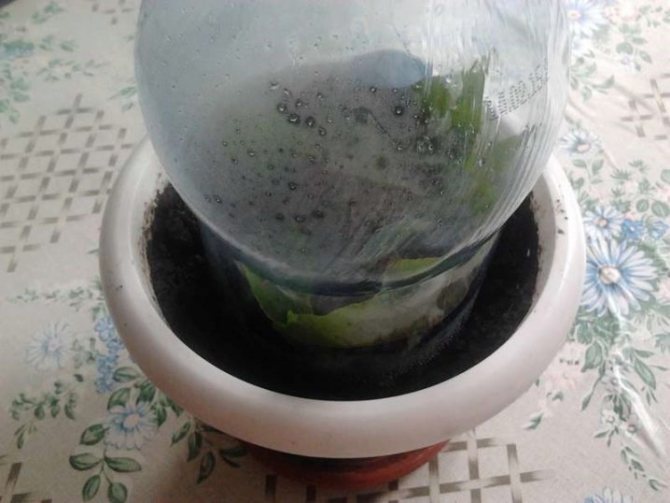

Reproduction
Reproduction by cuttings will help to protect yourself from the loss of your favorite specimen. For this, both a viable cut of the stem after flowering, having 3 - 5 buds of growth, and new shoots taken during the growing season, cut at an angle, are suitable.
Dip the resulting cuttings into water for 30 minutes so as not to lose the milky juice, then dry the cut ends with a napkin, treat with a growth stimulator.Fill the prepared container with a moistened substrate, dig in the stalk, not deepening much (1 cm).
Cover with a transparent cap, creating a greenhouse effect, airing every day, put in a well-lit, warm place. Water as the clod dries up. The first new sheet has appeared - the cap is being removed. Further maintenance according to the rules for the care of an adult flower. In a year the Christmas star will bloom.
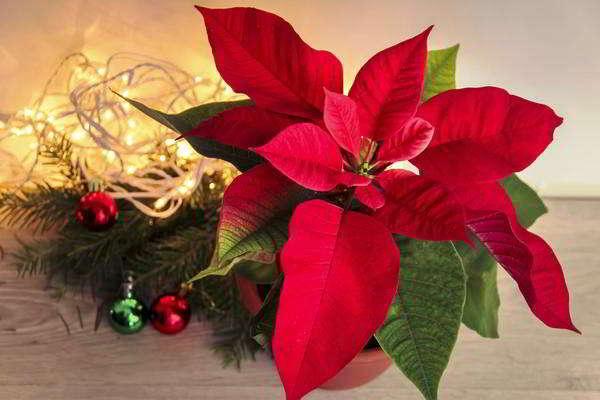

Watering poinsettia
Water abundantly as the soil dries up, however, it is often not recommended to water. If the soil cracks and the leaves dry out, pour the pot with the plant well with warm, settled water. You also need to spray the leaves during flowering.
After each watering, after 30 minutes, drain excess water from the sump, and to prevent root rot, you can put DECO PETER PEAT small river pebbles in the sump. Water stagnation in the tank must not be allowed during the recovery period (January-March).
Forum, reviews of florists
Such a beautiful flower cannot remain without enthusiastic or sad reviews on the Internet. Whole sections of dozens of pages of discussion, advice, wishes dedicated to the Christmas star.
Tatiana, Slavyansk, Ukraine.
She says that from her own experience she was convinced of the importance of photoperiodism for flowering, how she hid her beauty for 7 weeks under a black bag, the stipules began to stain and she stopped removing it, left it as it is. The stipules stopped staining, grew green, the flower did not bloom. "... hence the conclusion: the flower should be sent daily for 14 hours in the dark until it has enough beautiful red bracts."
Tatiana, Chimkent, Kazakhstan.
She says that she grows her poinsettia with a tree, at the moment she is about a meter tall, in the spring she prunes, removing crooked, unsightly, thin stems.
Lenochka (Master of Floral Collections).
Her flower is already 3 years old. After the purchase, it crumbled quickly, she cut it off, stood a poinsettia at +14 - + 15, watered it 2 times a month, the leaves appeared a month later, it grows quickly. She cut her hair twice in the summer. She did not suit her dark nights, she was very afraid that it would not bloom. But at the end of January, red stipules appeared, in February it was all bright red, the Christmas star bloomed from February to May. Then she cut it to half again, and so it has been for 3 years.
How to propagate poinsettia by cuttings
In August-September, from an adult poinsettia, cut the cuttings 7-10 cm long with 4-6 leaves, cutting directly under the bottom knot. Remove the lower leaves, and put the cuttings in a glass of warm water for 10 minutes to get rid of the "milk" flowing out of the slices. Then, for 4-5 hours, place in a stimulating solution of liquid humic fertilizer PETER PEAT "Vitality: for soaking seeds." Fill a 6-8 cm deep planting container with a wet substrate of sand, dry manure and humus (1: 1: 2) or PETER PEAT nutrient soil "For seedlings" of the HOBBY line and deepen the cuttings by 2-3 cm.
Keep the container at a temperature of + 24-28 ° C, cover it with a transparent film and turn on a phytolamp suspended at a distance of 30 cm above it. Ventilate the cuttings 3-4 times a day and spray with warm water 2 times a day, constantly checking the soil moisture. Remove the film for 8-10 days. Immediately after planting and once every 18-20 days, feed with PETER PEAT liquid humic fertilizer "Vitality: healthy seedlings".
Rooting of cuttings will end on 25-30 days, and when young leaves appear, the shoots should be pinched, starting to form bushes. The optimum temperature for their growth is + 18-24 ° С. In autumn, transplant the cuttings (with lumps of substrate!) Into pots 15-20 cm high and 15 cm in diameter. Full-fledged plants will form only after a year.
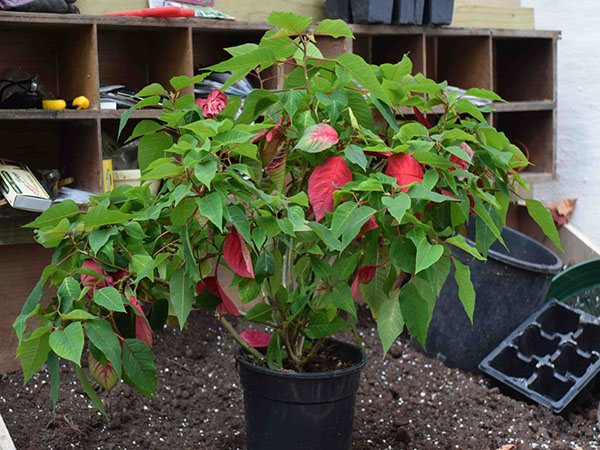

When the winter bloom of poinsettia ends, it may seem that the plant is dying, but this is not the case.Pruning and reproduction of poinsettia at home helps prolong the life of a flower. A timely and properly pruned perennial gives excellent planting material, and after rest it forms young shoots and blooms profusely.
A feature of poinsettia is winter flowering, accompanied by the appearance of a rosette of brightly colored bracts. Thanks to them, the plant received a second name - the Christmas star. It is not surprising that poinsettia in many countries is presented as a gift for the winter holidays. But when flowering is over, the compact shrub loses its decorative effect.
Novice growers sometimes take the fall of the foliage as a sign of death and mercilessly get rid of the flower. Take your time!
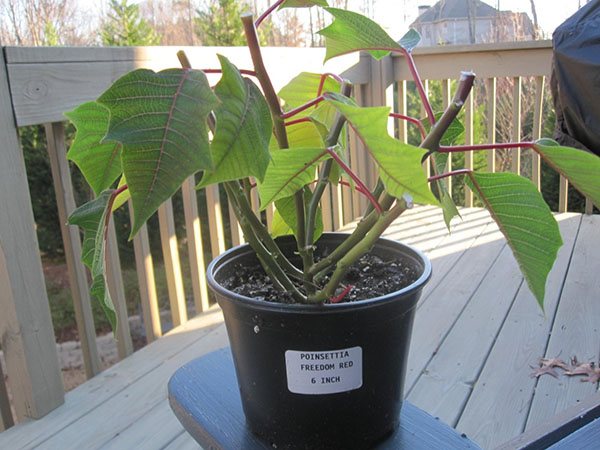

The plant only needs a period of rest, which is obligatory for poinsettia, which lasts about two months, and then leaves and decorative stipules surrounding the owl are formed again on the shoots.
How to make poinsettia bloom
The peculiarity of growing a Christmas star is that it cannot begin to bloom unless the necessary conditions are created for it beforehand. Starting in October, a special light regime must be created for the plant.
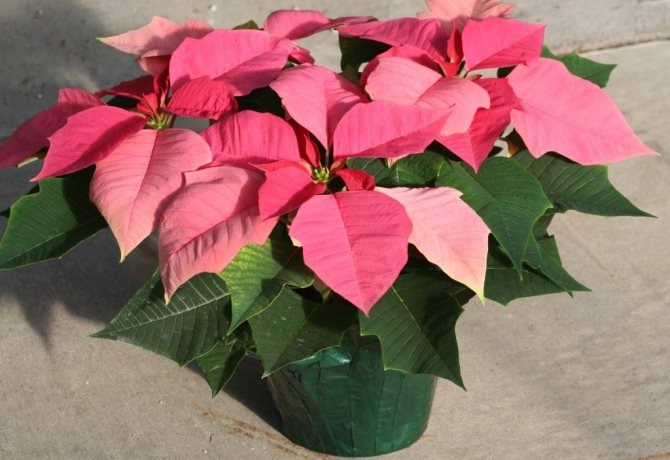

Every day it is necessary to cover the plant with a box or dark opaque plastic for 12-14 hours. In this case, it is worth slightly lowering the temperature regime (up to 17 degrees) and moderating watering. When the poinsettia begins to bloom, you can return to normal mode.
Temperature
The plant is thermophilic, the ideal ambient temperature during flowering should be 23-25 degrees Celsius. A constant temperature regime is especially important for the full flowering of the poinsettia.
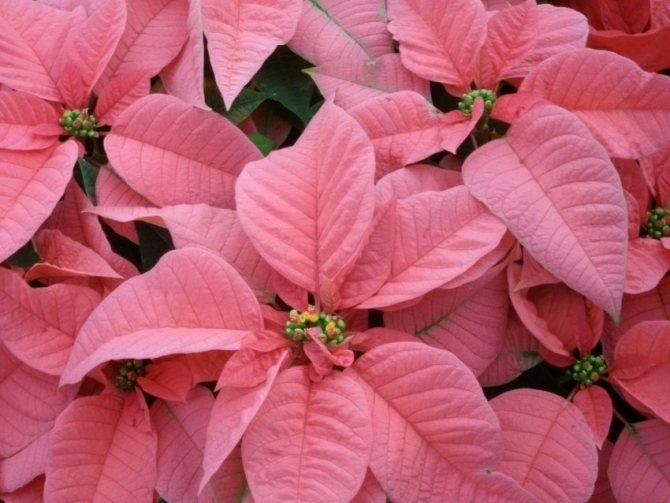

When the flower gains strength after flowering, it should be moved to a cooler place, but it should be borne in mind that the plant will not tolerate temperatures below 14 degrees Celsius.
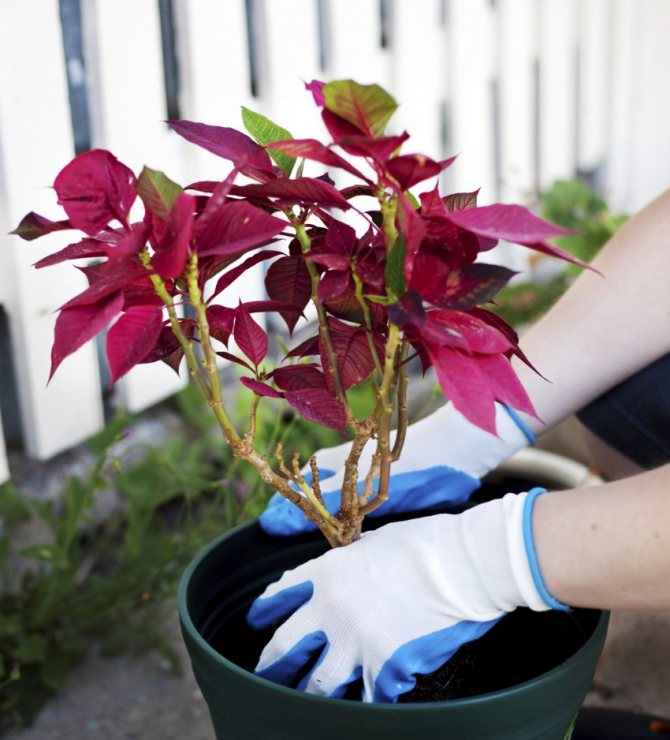

An important nuance - an indoor flower does not tolerate drafts well, therefore, when choosing a worthy place for it, you should choose a quiet and cozy shelf or a place in the corner of the room.
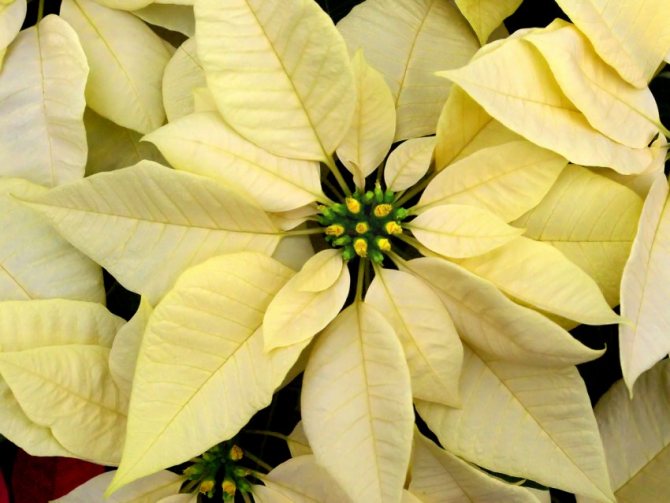

Potential diseases and parasites
Poinsettia can be attacked by parasites such as thrips, spider mites or mealybugs. Most often, these pests are brought from flower shops. You can eliminate parasites with a warm shower and soapy water.
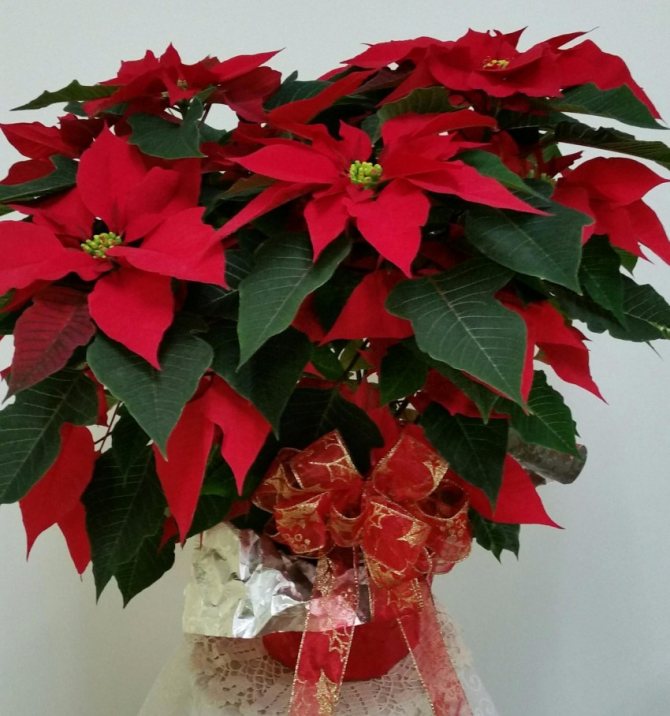

If you were presented with a poinsettia and you have already observed its flowering, then believe me, you will not be able to part with it. Caring for the plant is feasible and not difficult even for beginners. But every Christmas, with bated breath, you will expect the appearance of bright tides of the beautiful poinsettia and the holiday will become doubly brighter for you.
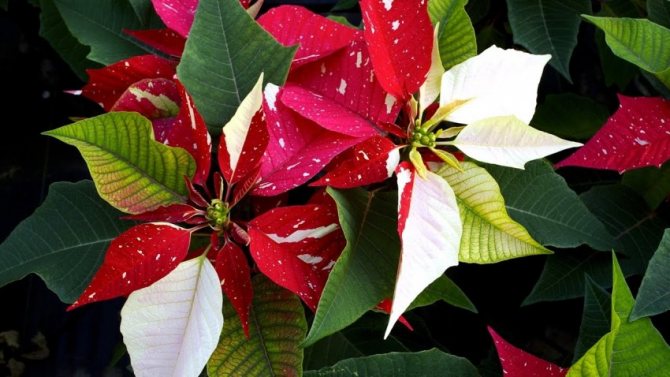

Varieties
Poinsettia Oak Leaf is the first cultivated variety obtained in the first half of the 19th century and named for its characteristic leaf shape, reminiscent of the foliage of American oak.
The true embodiment of Christmas can be considered the classic bright red Premium Red poinsettia with a yellow-green, like a glowing middle and pointed broad-lanceolate bracts.
Why does onion rot during storage and what to do?
Climbing rose: planting and care in the open field, photo
Barberry: planting and care in the open field, photo
For lovers of rich colors and laconic traditional forms, breeders have created a whole series of Cortez varieties dedicated to the conqueror of Mexico Fernan Cortez. The most solemn and memorable in this collection can be called the Cortez Burgundy poinsettia variety with crimson apical stipules.
Compared to the plants of this series described above, the Cortez Pink poinsettia variety is striking in its delicate purity. The golden core is surrounded by pink leaves, the tone of which becomes lighter with distance from the top.
The first of the "terry" varieties at the disposal of flower growers appeared the Poinsettia variety Winter Rose with a small greenish core and a luxurious rosette of fireplace leaves bordering it.
The peculiarity of the Premium Miro poinsettia variety is not only the curved, crinkled "petals", but also their double color, combining white, snow-white and pink shades.
The most beautiful spurge has a huge number of hybrid varieties with various shades of bracts. The most popular home-grown flower varieties are listed below.
Red poinsettias
- "Premium Red" - a classic deep red poinsettia with a yellowish core and lanceolate leaves;
- "Cortez Burgundy" - a variety with crimson stipules;
- "Cortez Red" - the variety is distinguished by red leaves with green veins.
Pink poinsettias
- "Cortez Pink" - pale pink color of the leaves, while the lower layer of bracts is paler in tone than the leaves at the top;
- "Winter Rose" - a terry variety of a pink plant with a greenish core;
- "Premium Miro" - a variety with white-pink "crushed" bracts.
White poinsettias
- "Winter Rose White" - has small green inflorescences framed by milk-colored double leaves;
- "White Star" - the variety is characterized by classic white bracts;
- "Polar Bear" - greenish-yellow flowers with white leaves in green veins.
Variegated varieties
- "Monet Twilight" - pink color of bracts with the effect of powdery white dusting;
- "Eckespoint Primero Gingle Bells" - raspberry shade of bracts with white blotches;
- Cinnamon Star is a newly developed plant with pinkish, salmon-orange shades of leaves.
Let's introduce you to some of the poinsettia varieties.
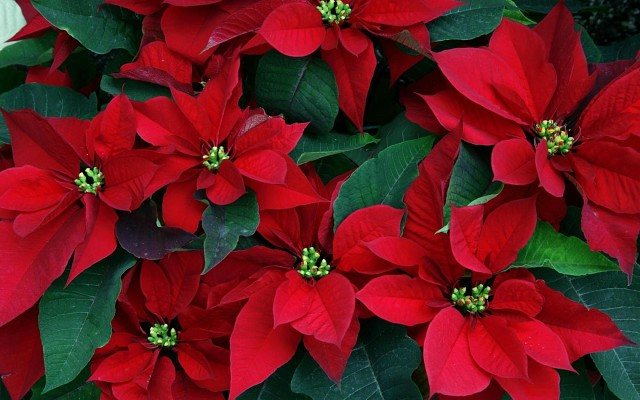

Most Poissettia varieties have a red bract.
Bright red bracts are characteristic of the following varieties: Sonora, Olympia, Galaktika, Annette Hegg Dark, Angelica, Barbara Eck Suprem, Goldfeinger, Emperor, Capri, Coco Red, Cortez, Xenia Red, Millennium, Premium Red.
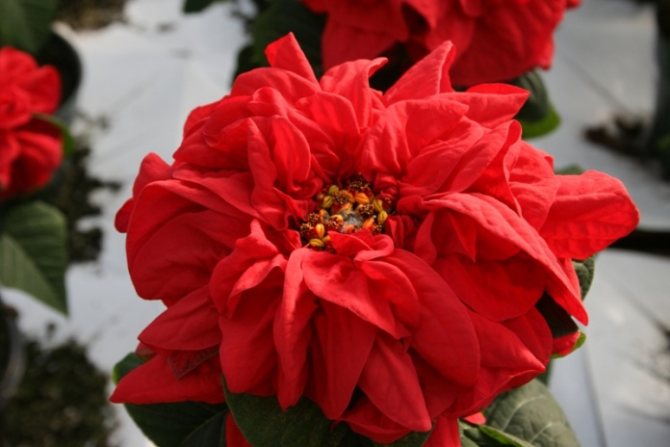

In the Winter Rose variety, the scarlet bracts are unusually wrapped, which makes this poinsettia look like a rose.
The Champion variety has a paler red bracts, while the Red Jester variety has dark streaks on the red stipules. Pure scarlet bracts are found in the varieties "Red Diamond" and "Svoboda".
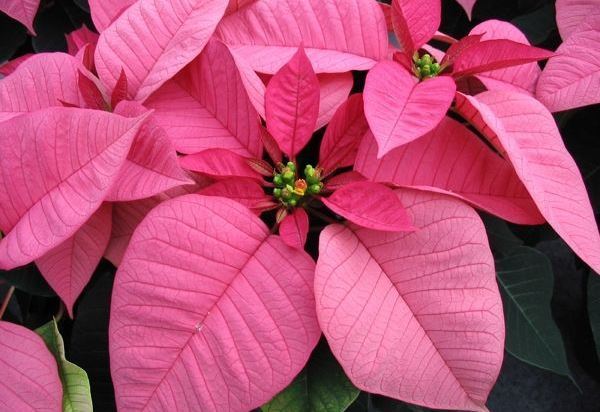

Poinsettia Da Vinci
Gentle pink bracts have the following poinsettia varieties: Annette Hegg Pink, Da Vinci, Dorothy, Festival Rose.
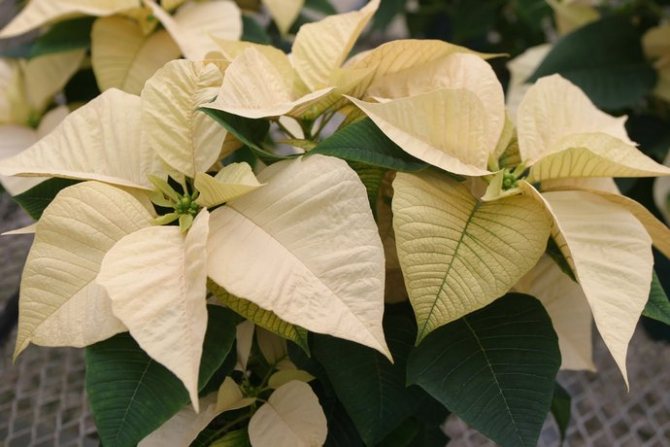

Poinsettia Cortez White
Pure white bracts are of the following varieties: Annette Hegg White, Sonora White, White Star, Cortez White.
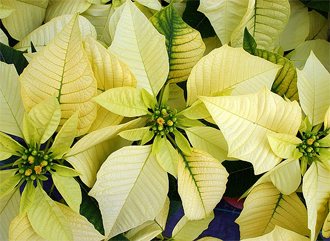

The white bracts of the Regina variety have green veins.
Cream-colored bracts adorn the following poinsettia varieties: Marble, Regina, Pink Ribbon, White Freedom.
The Maren variety impresses with a milky pink-tinted flower garden, while the Silver Marble is characterized by pink stipules with a white border. The variety "Strawberry with cream" has pink - purple bracts with jagged edges.
Seed method
In the wild, after the end of the flowering period, euphorbia gives seeds, which, scattering, give life to new plants. Such material is very difficult to obtain with the artificial method of breeding poinsettia, moreover, the most beautiful varieties of this plant are the result of many years of selection work, while the seeds, unfortunately, do not retain the acquired characteristics, and a wild plant grows from them. It is not so beautiful, more poisonous than the cultivated varieties, so propagating the Christmas star by seed is not only pointless, but also dangerous. Thus, poinsettia does not leave much choice for growers as to how to breed it.
Why do poinsettia leaves turn yellow and fall off?
Basically, it's all to blame - improper care and unacceptable conditions for a flower.Pests can also lead to this phenomenon. But often Poinsettia's leaves begin to fall off when the dormant period begins for her - in this case, dropping the leaves is a common thing. But only if it happened in late February or early March. If not, then, most likely, there is another reason. There are several solutions: you can transplant the plant, feed it with fertilizers, water it well. You can rearrange the plant to another place, cut the stems to half. Having reanimated the flower, remove its shoots, leaving the strongest ones - this way Poinsetia will live longer. And, of course, it will prosper!
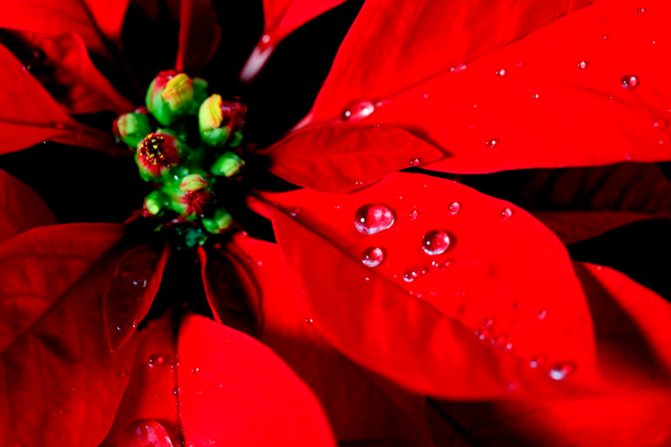

Watering and moisture, top dressing
The beautiful poinsettia needs frequent watering during the flowering period and in the summer, when it is actively increasing its green mass. It is not necessary to water the flower every day, on the contrary, it can lead to decay of the roots. Each subsequent watering is carried out when the topsoil is dry. Water for irrigation is always warm, preferably settled. During the dormant period, watering is reduced to moderate. It is enough not to allow the soil to dry out.
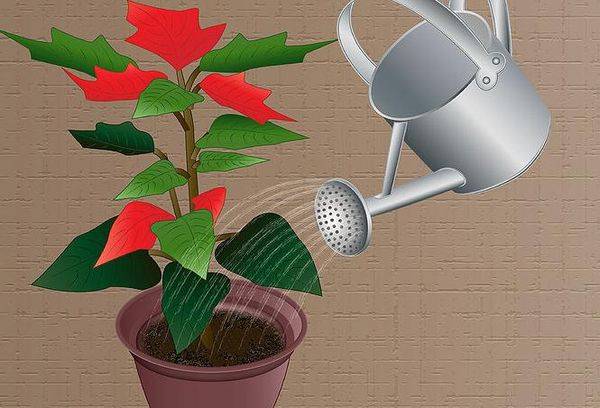

Poinsettia is demanding on air humidity. In a too dry room, it often sheds its leaves and refuses to bloom. Miss Cleanliness magazine strongly recommends spraying poinsettia leaves with warm water, especially in winter, when the apartment is warm and dry due to heating systems. There is another danger in moisture deficiency. Dry air is an excellent environment for the existence of a pest - a spider mite. Complementary foods are divided into two periods:
- In spring and summer, when the plant is actively developing, it needs complete mineral fertilization.
- In autumn and until the end of the flowering period, the most beautiful euphorbia needs potassium-phosphorus supplements.
Fertilization - every two weeks. Organic fertilizers are suitable for flowering plants.


Optimal lighting for poinsettia at home
A tropical plant with a short color day. That is, poinsettia blooms only in winter, when it begins to darken early in our country. Many are unaware of this feature and turn on bright lighting next to the flower, thus confusing it.
In normal mode, the flower needs bright light, but not in direct sunlight, otherwise all decorativeness will go away and in general the flower may get burns.
Most often, the plant is lodged in the southeastern windows, so that it has enough light, it is illuminated with lamps. It should be remembered that daylight hours cannot be artificially increased for them, otherwise it will not bloom.
During flowering, the air temperature must be maintained at 14-16 ° C, not lower. At other times of the year, the spurge is quite unpretentious and the average room temperature of 18-25 ° C will be quite acceptable. A decrease in temperature by several degrees at night will have a beneficial effect on the plant.
Poinsettia care at home. In detail
| Temperature regime | In summer and during the growing season, a temperature of 20-21 ºС is required, during the dormant period - no higher than 14 ºС. |
| Air humidity | High, maintained at a level of at least 80%. |
| Lighting | Bright, sunny, except for the midday rays. |
| Watering | Frequent, more than 2 times a week, preventing the soil from drying out. After flowering - once every 10 days. |
| Poinsettia soil | Nutritious, moisture-permeable with high-quality drainage. |
| Top dressing and fertilization | Mineral complexes for beautiful blooming flowers throughout the entire period of active growth. |
| Poinsettia transplant | Held annually at the end of the dormant period. |
| Reproduction | Apical cuttings. |
| Growing features | The flower does not tolerate drafts, needs annual pruning. The sap of the plant, contrary to popular belief, is not poisonous, but it can cause irritation in people prone to allergic skin reactions. |
Blooming poinsettia
The Christmas Star blooms in the midst of winter, from December to February.These are very small inconspicuous inflorescences in the form of greenish flowers-buttons, surrounded by large leaves-bracts, which just create the appearance of flower petals, give the plant a rich decorative appearance.
Bracts have a wide variety of shades depending on the variety, from burgundy red to peach tones. At the end of flowering, the leaves fall off, after which not everyone can reanimate the flower, save it until the next flowering cycle.
To resume the life of the flower and re-flowering, it is recommended to follow a few simple rules for care:
- prune the plant, leaving 4-5 strongest shoots;
- from the end of September, the plant must be covered with a dense opaque cap made of paper or polyethylene and, with the onset of dusk, removed to a dark place for at least 12-14 hours;
- in the morning the flower returns to the window, and with the arrival of evening it is also hidden from any kind of lighting;
- the plant is provided with moderate watering.
After about 2 months of such storage, poinsettia begins to "wake up" and grow young foliage. After another two weeks, flower buds appear and bracts bloom.
It is not recommended to put vases with apples, bananas, pears and other fruits near the blooming poinsettia, since the plant gas ethylene emitted by them has a detrimental effect on the bracts - they quickly wither.
Temperature regime
Home poinsettia feels comfortable at a constant temperature of 20-21 ºС during the day, and at least 16 ºС at night. At the same time, it is very important to exclude any contact of the flower with the cold - drafts, frosty glass windows, cold streams from the street. All these factors can cause a sharp fall of foliage.
Spraying
In the summer season, the poinsettia plant at home does not tolerate dry air, therefore it is very important to maintain a consistently high humidity using special humidifying devices, or through regular spraying. For this, soft filtered or settled warm water is used.
Lighting
Poinsettia is a light-loving flower that requires diffused sunlight shaded from the scorching midday light. But for the timely laying of flower buds and successful flowering, daylight hours are artificially reduced to it, completely closing the bush for 12-14 hours.
Such changes stimulate the development of poinsettia - the bracts will be colored brightly and evenly. If you neglect this rule, the leaves can become covered with dark spots.
Watering poinsettia
The main rule of watering poinsettia is moderation. In the phase of active growth of a flower, the soil is moistened only if its upper layer has dried out to a depth of about 1.5 cm, that is, not more often than after 2-3 days. Overflow, as well as excessive dryness, are equally detrimental to the plant.
For irrigation, use softened settled water about 3 degrees warmer than room temperature.
As a rule, the poinsettia is transplanted into a pot a couple of centimeters wider than the previous one. The size is selected in such a way that after transshipment of the root ball, there are still 2-2.5 cm of voids around, which are subsequently covered with fresh soil.
The plant prefers slightly acidic nutrient soil. It is recommended to use a special euphorbia soil. But more often a mixture is used, including the following components:
- clayey sod soil (3 parts);
- leafy soil (2 parts);
- peat (1 part);
- coarse river sand (1 part)
In addition, you can use a lighter, permeable substrate, consisting of 3 parts of humus, 2 parts of peat and 2 parts of vermiculite. For any type of soil, a full-fledged drainage layer is required.
Caring for poinsettia at home includes the regular introduction of feeding products. During the growing season, the flower is fertilized with liquid mineral complexes with a frequency of 2 times a month.It is recommended to use special feeding for euphorbia, fertilizers for succulents are also suitable.
Transfer
At the end of the dormant phase, around March-April, it is advisable to transplant the plant into a fresh nutrient substrate. The transplant is carried out with the maximum preservation of the root ball, for which half an hour before removing the flower from the pot, the flower is well watered. If damaged blackened roots are found, they are carefully trimmed with a disinfected tool.
Then the cuts are sprinkled with charcoal or ash, and the plant is placed in a new pot and covered with fresh soil without compaction. The planted poinsettia is left in the shade for two days and without watering, in order to stimulate root growth. Then the plant is placed in a sunny place, watering abundantly and sprinkling regularly.
Poinsettia at home undergoes annual pruning, either immediately after flowering, before the onset of the dormant period, or a week before its end before transplanting. Such a measure spurs the growth of young lateral shoots and gives the plant a compact appearance.
... Pruning is also necessary if, during the growth process, the shoots are strongly stretched and the bush loses its decorative effect. In this case, the branches are cut to 15 cm from the ground surface. Since they grow very quickly, this procedure is performed 3 times a year.
Dormant period
Poinsettia needs regular rest, which usually occurs immediately after flowering. When the leaves and bracts of milkweed begin to fall off, the remaining withered, dry branches are cut from the plant and removed to a cool place. The soil is moistened very moderately once a week. The end of the flower rest period falls on the beginning of May.
When you need to leave the plant at home for a long time without the possibility of regular watering, there are several ways that you can maintain the desired level of soil moisture:
- A plant without a pallet is placed in a large container filled with water. Through the drainage hole, the roots of the flower will be nourished with moisture when needed.
- Wick watering. To do this, a cord made of any synthetic material that is not subject to decay is passed through a drainage hole in a flower pot and its other edge is dipped into a container with water. The flower can be fed in this way for quite some time. The main thing is to pour enough water.
- Use of automatic irrigation systems.
For poinsettia, flowering is the main decorative value. Actually for the sake of this, these indoor plants are bred. And why some flower growers do not bloom poinsettia is a matter of competent distillation. Subject to the light and temperature conditions, as well as with the correct maintenance of the plant during the dormant period, it will certainly bloom.
Why do indoor poinsettes not resume growth after a dormant period? The reason for this can only be improper care: excessive watering, overdrying of the earthy coma, too low room temperature. Yellowing of the leaves can be either a sign of the transition of the poinsettia to a dormant state, or a sign of a disease.
But if you properly care for this extraordinary plant, provide it with a comfortable temperature regime and competent watering, then at home it will repeatedly delight you with its wonderful flowering. And although caring for poinsettia is not entirely easy, it is its flowering that more than compensates for all your efforts.
In most cases, poinsettia blooms until the end of February, during this period it sheds its leaves and a dormant period sets in, most people believe that the plant dies and throw it away.
To provide the poinsettia with good growth and abundant color, it must be cut in half and provide the plant with a shaded cool place (at least 10 ° C); you need to reduce watering, keep in a shaded place until the end of the night spring frosts, then take it out into the open air in the shade.
Poinsettia loves bright, but soft, diffused light. Choose windows facing west or east for her. But place the pot not on the windowsill, but on a table or shelf near it, since direct sunlight is unacceptable for the leaves. In the summer, it is possible to take the flower pot out into the open air, just protect the flower from direct sunlight, drafts, precipitation and wind.
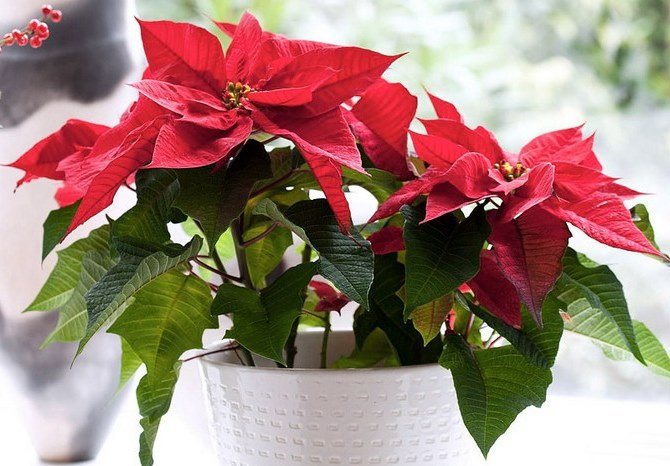

Poinsettia doesn't like hitting direct sunlight best
In winter, it is not advisable that the delicate poinsettia leaves touch the cold window glass. You can not place the pot in front of an open window - low temperatures and drafts will have a detrimental effect on the health of the plant. For normal lighting in winter, the rest for poinsettia is usually six to eight hours.
Temperature
We follow the sprouts
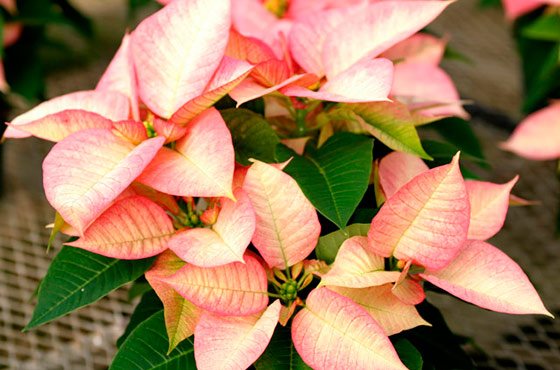

Open the film periodically to provide fresh air for the sprouts. To avoid drying out, spray the cuttings with water at each airing.
Usually, at home, the cuttings take root only after a month, and at this time the film can be removed. The established sprouts feel favorable at a lower air temperature, but it should not be lower than 16 degrees.
By the middle of autumn, the sprouts turn into full-fledged plants. At this time, they need to be transplanted into pots with a diameter of twenty centimeters. All-purpose soil from the store is fine for this.
As for flowering, a young poinsettia will delight you with the first flowers only after a year. But it will be a flower that you yourself have grown! In addition, the first plant from which the branches were taken will continue to live in this way.
Transplant - friend or foe?
Sometimes it is necessary to transplant poinsettia. This is a meaningful action, on the success of which the well-being of the pet depends. Thanks to the transplant, the plant gets a chance to grow further.... But, it is always necessary to remember that this is stress for the flower.
The first reason for transplanting is the soil drying out too quickly, which means that the roots have taken up all the space and the pot has become small. Another signal can be a bad substrate. Earthen mixtures may not meet the needs of this flower. Less often, due to soil pests, it is necessary to change the substrate.
Vegetative way
In order to propagate the poinsettia using a cutting, it is necessary to cut off the top of about 7 cm long with noticeable buds from a young shoot of an adult, but not old plant (there should be at least three, preferably five to six). Trimming is done underneath the bottom knot. The stalk should be soaked for several minutes in warm water, placed in the rooting solution, then blotted on the cut and disinfected (for this purpose, you can use ordinary activated carbon). The treated shoot is planted in well-moistened soil with the addition of humus, manure and sand. Important! If the cutting is buried in the ground deeper than a centimeter, rooting will not occur, and the lower part of the shoot will simply rot! The pot is covered with foil and placed in a very warm and light place for rooting, but shaded from the direct sun. Do not forget to regularly ventilate and spray the cuttings. The roots appear in about a month. As the plants grow, they are transshipped into larger containers and pinched to give the poinsettia a magnificent shape. If the plant is planted correctly, it begins to bloom as early as next year.
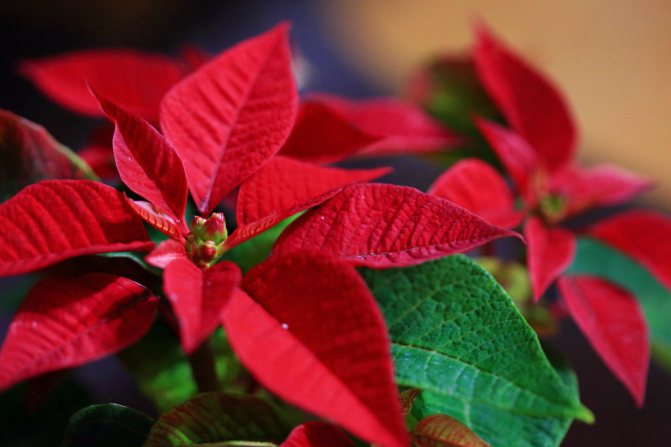

What if the plant does not take root?
Sometimes it happens that the plant does not take root. Perhaps during transplantation, the root system was damaged or putrefactive processes developed. If this happens, you need to repeat the steps again. Before transplanting, the root system should be dipped in Kornevin. It will help her develop and improve rooting. If the plant cannot be reanimated, it is necessary to start planting from a cutting.
Poinsettia is a beautiful flower, but it requires some maintenance. When working with it, you should be careful. Improper handling of the plant can cause irritation of the skin and mucous membranes.
When growing poinsettia, questions may arise, so we recommend that you familiarize yourself with our materials:
- What to do if poinsettia gets sick and sheds its leaves in December?
- When to trim a poinsettia and how to do it wisely?
- Why is poinsettia not blooming and what to do?
Why don't the leaves of Poinsettia turn red?
In order for Poinsetia to bloom, it must be placed ... in a dark place. The fact is that in Central America, the place where the flower originates, the daylight hours are short - only 10 hours, while the dark time of the day lasts the remaining 14 hours. So Poinsettia needs such a regime for flowering. For this purpose, you can cover it with a bag, and it is best to put it in a dark cabinet. This must be done at a certain time: set at 6 pm, in the morning, at 8 o'clock - got it. The main thing is not to forget! If you do everything right, then in a month the flower will be decorated with red and yellow leaves.
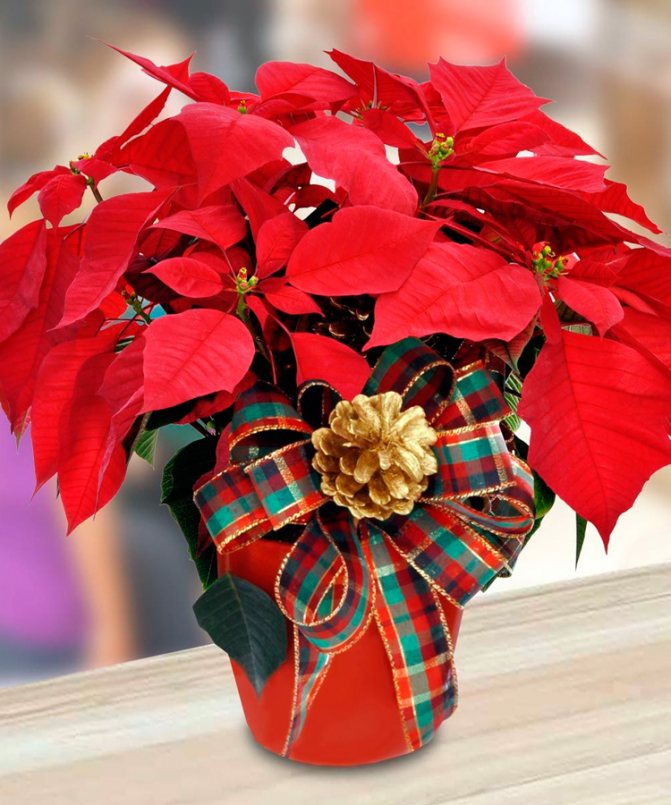

Blooming Christmas Veil
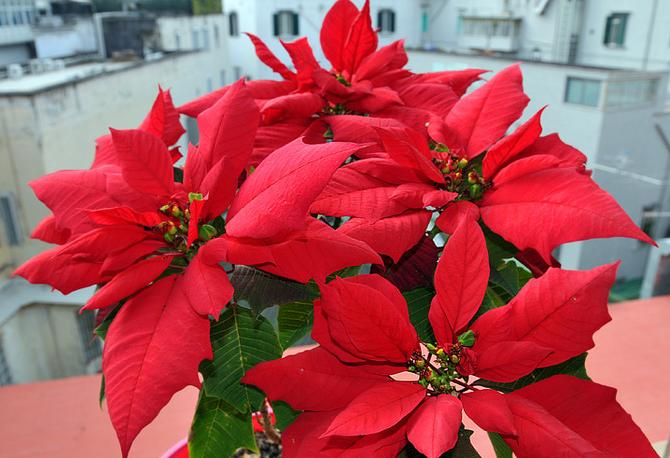

Bracts acquire a bright red color closer to the New Year holidays
In a couple of months, at the end of November, small greenish formations will appear on the tips of the shoots of the plant, similar to small buttons. Watch the development of the buds and you will see that they become more noticeable every day. Throughout autumn and December, the leaves of the bracts also grow - they are arranged in a spiral.
It's time to return the pot to its original, warm and bright place. Closer to the New Year holidays, the bracts acquire a bright color, most often red, which gives the indoor flower a chic festive look. Some unknowingly consider these bright and unusually beautiful bracts to be poinsettia flowers. In January, the bracts reach their maximum size and brightness, after which they begin to fade and fall off.

